
About UsThe Numismatic Bibliomania Society is a non-profit association devoted to the study and enjoyment of numismatic literature. For more information please see our web site at coinbooks.org SubscriptionsThose wishing to become new E-Sylum subscribers (or wishing to Unsubscribe) can go to the following web page link MembershipThere is a membership application available on the web site Membership Application To join, print the application and return it with your check to the address printed on the application. Print/Digital membership is $40 to addresses in the U.S., and $60 elsewhere. A digital-only membership is available for $25. For those without web access, write to: Charles Heck, Treasurer
AsylumFor Asylum mailing address changes and other membership questions, contact Terry at this email address: terrywhite5475@yahoo.com SubmissionsTo submit items for publication in The E-Sylum, write to the Editor at this address: whomren@gmail.com |
- WAYNE'S WORDS: THE E-SYLUM MARCH 24, 2019
- NEW BOOK: CURIOUS CURRENCY, SECOND EDITION
- GUIDE BOOK OF BARBER SILVER COINS RECOLLECTIONS
- GUIDE BOOK OF MORGAN SILVER DOLLARS HISTORY
- DECEMBER 2018 CHOPMARK NEWS PUBLISHED
- NEIL ROTHSCHILD (1956-2019)
- ANN M. ZAKELJ (1947-2019)
- DR. RAINER OPITZ (1954-2019)
- BOWERS RARE COIN REVIEW ON NEWMAN PORTAL
- COMPUTER UNDERSTANDING OF ANCIENT COIN IMAGES
- IDENTIFYING THE RECIPIENT OF AN AWARDED MEDAL
- NOTES FROM E-SYLUM READERS: MARCH 24, 2019
- HARVEY STACK RECALLS KRAUSE PUBLICATIONS START
- VOCABULARY TERMS: INSCRIPTION
- SIEGMUND KOHN HARZFELD (1848-1883)
- 2019 PITTSBURGH NATIONAL MONEY SHOW HIGHLIGHTS
- ANA MUSEUM MOUNTS MONEY OF EMPIRE EXHIBIT
- NUMISMATIC LINGUISTICS
- U.S. MINT DIRECTOR DAVID J. RYDER INTERVIEWED
- KAGIN'S MARCH 2019 ANA AUCTION PREVIEW
- CNG OFFERS COINS OF THE VALERIANIC DYNASTY
- NUMISMATIC AUCTIONS LLC SALE 63
- NUMISMATIC NUGGETS: MARCH 24, 2019
- JERSEY GROUVILLE HOARD WAS TWO COLLECTIONS
- QUERY: DRAKE'S PLANTATION BITTERS INFO SOUGHT
- QUERY: 1771 PUGACHEV ROUBLE
- QUERY: U.S. COINAGE MINTAGE FIGURES SOUGHT
- NEW STEPHEN HAWKING 50-PENCE COIN
- STAR OF ITALY FOR WOMAN WHO FOOLED NAZIS
- JAPAN'S MANHOLE COVERS
- WALLET HELPS IDENTIFY BANKNOTE DENOMINATIONS
- NEW JERSEY BANS CASHLESS STORES
- LOOSE CHANGE: MARCH 24, 2019
- FEATURED WEB SITE: NUMISMATIC NOTEBOOK
Click here to access the complete archive a
Click here to unsubscribe (scroll down)
To comment or submit articles, reply to whomren@gmail.com
Content presented in The E-Sylum is not necessarily researched or independently fact-checked, and views expressed do not necessarily represent those of the Numismatic Bibliomania Society.
WAYNE'S WORDS: THE E-SYLUM MARCH 24, 2019
 New subscribers this week include: Jerry Diekmann and Jerome Nashorn. Welcome aboard! We now have 5,839 subscribers.
New subscribers this week include: Jerry Diekmann and Jerome Nashorn. Welcome aboard! We now have 5,839 subscribers.
Thank you for reading The E-Sylum. If you enjoy it, please send me the email addresses of friends you think may enjoy it as well and I'll send them a subscription (but let me know if they are located in the European Union). Contact me at whomren@gmail.com anytime regarding your subscription, or questions, comments or suggestions about our content.
This week we open with one new book, two book publication histories by Dennis Tucker, a new periodical issue, three obituaries, new content on the Newman Numismatic Portal, and a new approach to computer understanding of ancient coin images.
Other topics this week include Numismatic News, dealer S. K. Harzfeld, the ANA Pittsburgh National Money Show, multiple auction previews, reader queries, the new Stephen Hawking coin, and a new ban on cashless stores.
To learn more about woodpecker scalp money, Rare Coin Review, fippence, the falsification of ancient coins, erotic tesserae, brothel tokens, the Armada medal, coins of the Valerianic Dynasty, the Pugachev rouble, rhyming inscriptions, blundered inscriptions, and the Esperantist Checking Bank, read on. Have a great week, everyone!
Wayne Homren
Editor, The E-Sylum
NEW BOOK: CURIOUS CURRENCY, SECOND EDITION
A new edition of Bob Leonard's Curious Currency has been published by Whitman. -Editor
Robert Leonard's Updated Curious Currency, Second Edition, Explores Money from the Stone Age to the Internet Age
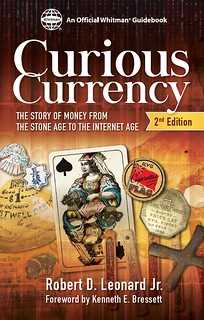 Whitman Publishing announces the release of the second edition of Robert D. Leonard Jr.'s award-winning Curious Currency: The Story of Money from
the Stone Age to the Internet Age. The 160-page hardcover book will debut March 12, 2019, two weeks before the American Numismatic Association's National
Money Show. It will be available from booksellers and hobby shops nationwide, and online (including at www.Whitman.com), for $16.95.
Whitman Publishing announces the release of the second edition of Robert D. Leonard Jr.'s award-winning Curious Currency: The Story of Money from
the Stone Age to the Internet Age. The 160-page hardcover book will debut March 12, 2019, two weeks before the American Numismatic Association's National
Money Show. It will be available from booksellers and hobby shops nationwide, and online (including at www.Whitman.com), for $16.95.
The first edition of Curious Currency earned the Numismatic Literary Guild's prestigious "Best Specialized Book on World Coins" award. The updated second edition includes new information from the most recent era of the money spectrum-PayPal and e-gold, proximity payments, cellphone payments, and cryptocurrencies like bitcoin.
The rest of the book is a treasure chest of cold, hard cash-and also feathery, leathery, tiny, gigantic, edible, and incredible cash. Leonard, a fellow of the American Numismatic Society and author of more than twenty studies on specific unusual monies, gives a colorful, entertaining, and authoritative tour of hundreds of strange things people have used as money through the ages, including:
- woodpecker scalps, whiskey, and gigantic stones
- wooden nickels, porcelain tokens, and playing cards
- elephant tails, iron nails, and whale teeth
- ostrich shells, bricks of tea, blocks of salt, human skulls, and more
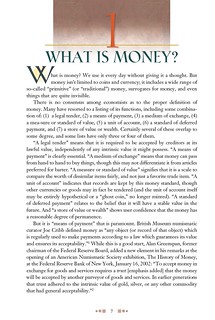
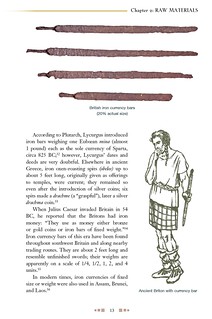
The essence of Leonard's exploration is to answer the question, "What is money?" He writes, "We use it every day without giving it a thought. But money isn't limited to coins and paper. It includes a wide range of so-called primitive or traditional currency, surrogates for cash, and even things that are quite invisible. The study of these odd and curious monies has lessons for our economy today."
Kenneth Bressett, Editor Emeritus of the Guide Book of United States Coins, calls Curious Currency "a fresh approach to understanding the nature of money… an entertaining overview … a provocative study."
Q. David Bowers, past president of the American Numismatic Association, says, "Bob Leonard's magnificent book is the 'missing link' in hobby publications. We know about silver dollars, Gold Certificates, colonial coins, and ancient decadrachms, but odd and curious money is equally important and fascinating. The subject is strange and wondrous. This is money like you've never seen it before."
Scott Semans, expert and longtime dealer in ethnographic money, calls Curious Currency "Both a popular work with 200 color photos, and a meticulously researched reference with footnotes, bibliography, and a good index" and "Highly recommended both for collectors desiring perspective, and as a gift for those who appreciate beauty in utilitarian things."
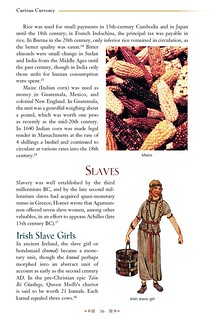
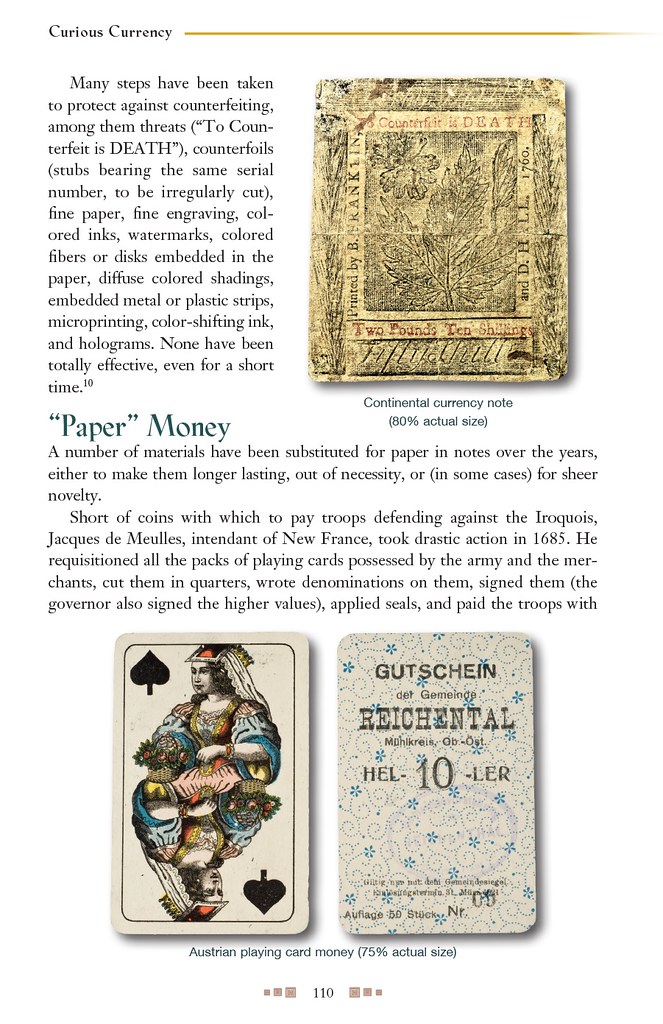
Curious Currency: The Story of Money from the Stone Age to the Internet Age, 2nd edition
By Robert D. Leonard Jr.; foreword by Kenneth Bressett
ISBN 0794846394
Hardcover, 6 x 9 inches, 160 pages, full color, retail $16.95 U.S.
https://www.whitman.com/store/Inventory/Detail/Curious-Currency-2nd-Edition+0794846394

GUIDE BOOK OF BARBER SILVER COINS RECOLLECTIONS
Dennis Tucker of Whitman Publishing submitted these recollections on the creation of the Guide Book of Barber Silver Coins. Thanks. -Editor
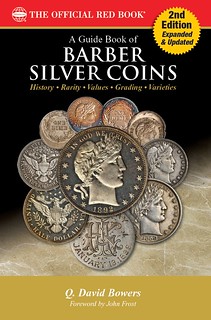 The silver coins of U.S. Mint chief engraver Charles Barber have enjoyed a rise in popularity in recent decades. The Barber Coin Collectors' Society
was formed in 1989, saw slow but steady growth for several years, and then experienced a vibrant rebirth under the leadership of Phil Carrigan (as president)
and David Lawrence Feigenbaum (as the Society's journal editor) starting in 1994. Current BCCS president and journal editor John Frost describes those early
years: "By the time I joined in 1995, the Society was strong and in full swing. Lots of new information poured into the Journal, and our meetings at the
American Numismatic Association conventions included interesting discussions of what had been learned in the past year."
The silver coins of U.S. Mint chief engraver Charles Barber have enjoyed a rise in popularity in recent decades. The Barber Coin Collectors' Society
was formed in 1989, saw slow but steady growth for several years, and then experienced a vibrant rebirth under the leadership of Phil Carrigan (as president)
and David Lawrence Feigenbaum (as the Society's journal editor) starting in 1994. Current BCCS president and journal editor John Frost describes those early
years: "By the time I joined in 1995, the Society was strong and in full swing. Lots of new information poured into the Journal, and our meetings at the
American Numismatic Association conventions included interesting discussions of what had been learned in the past year."
Today the group has members nationwide and is very active. Barber-related courses are taught at the ANA Summer Seminar in Colorado Springs, research is ongoing and robust, and the BCCS hosts meetings at regional coin shows, stages exhibits, and sponsors educational programs throughout the year. The Journal features a growing variety of articles and full-color "Featured Collections." "We believe in education as one of the BCCS's key missions," says Frost. "Many newer collectors get their first real overviews of Barber coinage at one of our programs."
Along with the birth of the Barber Coin Collectors' Society, by the late 1980s the coins had attracted the attention of researchers who shared their knowledge in books and articles. Q. David Bowers, by then well established as a leading coin dealer and numismatic scholar, had studied the silver Barber series for many years. In 1986 he published United States Dimes, Quarters, and Half Dollars: An Action Guide for the Collector and Investor. He wrote "Barbers, a Unique Perspective to Their History, Beauty, and Rarity" in 1989, the first year of the Journal of the Barber Coin Collectors' Society.
David Feigenbaum, writing as David Lawrence, published the Complete Guide to Barber Quarters in 1989 and 1994, and similar guides to Barber dimes (1991) and half dollars (1992). (These all went out of print but were made publicly available, online, about 20 years after publication.)
Throughout the 1990s and continuing to the present, the Cherrypickers' Guide to Rare Die Varieties, by J.T. Stanton and Bill Fivaz, has featured coverage of doubled dies, repunched mintmarks, and other collectible variations in every U.S. coin series including the silver Barbers.
Other Barber-specific books followed. The Complete Guide to Certified Barber Coinage, by David and John Feigenbaum, a 146-page reference published in 2000, gave "information essential for purchasing Barber coinage, including history, rarity ratings, and date and mintmark analysis." Other self-published books on Barber dimes, quarters, and half dollars emerged in the early 2000s, showcasing many previously unpublished die varieties. In 2009 Jeff Ambio's Collecting and Investing Strategies for Barber Dimes, a 432-page guide, shared detailed analyses of Proof and circulation-strike Barber dimes and their market performance, and advice on collecting.
Meanwhile, other research and analysis continued, and more and more Barber articles were published in Coin World, Numismatic News, The Numismatist, and similar hobby periodicals. The coins of Charles Barber were highlighted among the 100 Greatest U.S. Coins (by Jeff Garrett and Ron Guth, first edition 2003), studied in the Guide Book of United States Type Coins (by Bowers, first edition 2005), and covered annually in the Guide Book of United States Coins (the hobby's popular "Red Book").
Against this backdrop, in June 2014 I asked Dave Bowers what he thought of adding A Guide Book of Barber Silver Coins to Whitman's Bowers Series lineup. We had already studied Charles Barber's copper-nickel five-cent pieces in volume 5 (the Guide Book of Liberty Head and Buffalo Nickels, 2006). And we had the successors to the Barber dime, quarter, and half dollar slated for publication in the Guide Book of Mercury Dimes, Standing Liberty Quarters, and Liberty Walking Half Dollars, which would become volume 18 in the Bowers Series, published in July 2015. The time seemed ripe to focus an entire Whitman book on the chief engraver's most famous coins.
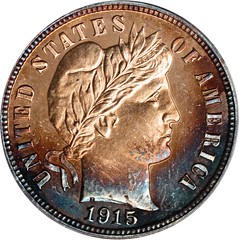

Dave jumped into the Barber coin project with his usual gusto, tapping into his extensive research archives and marshaling specialists around the country, including many members of the Barber Coin Collectors' Society. A solid year of work went into the effort. On August 12, 2015, at the American Numismatic Association World's Fair of Money in Chicago, Dave and I spoke at the annual meeting of the BCCS. Everyone was excited for the new book's debut. It came out a month later, in September 2015.
The Guide Book of Barber Silver Coins inspired Kenneth Bressett, then senior editor (and now editor emeritus) of the Guide Book of United States Coins, to fondly recall his early days of collecting in the 1940s. "There is no going back to those halcyon days of finding Barber coins in circulation," he wrote in the foreword to the first edition. "Today there is a new era of interest in these classic items, and one with new attitudes about the value and desirability of mintmarks, condition, and varieties. It is also a time when these coins can be more fully appreciated for their place in our nation's numismatic history." He praised the new book as "a fresh landmark account of Barber coinage touching on every aspect of availability, condition, varieties, history, and collectability of these fascinating coins."
The hobby appears to share Ken Bressett's appreciation. Collectors bought thousands of copies of the first edition of the Guide Book of Barber Silver Coins. Now, a few years later, we have the second edition.
What does the numismatic community look like today for Barber coin collectors?
Many active hobbyists focus on Fine, Very Fine, and Extremely Fine grades. This makes a full set of the three denominations, minus the 1894-S dime, an affordable quest for many BCCS members. A number of collectors are also building AU-55 to -58 sets. Most surviving coins are in About Good or Good-also widely collected, and even more affordable.
Although the vast majority of Barber coins are found in low circulated grades, the series also have their adherents among registry-set collectors. These are specialists who compete to build sets of the finest-graded coins they can assemble, ranked against others in competitions coordinated by the major third-party grading firms. In the spring of 2019, PCGS has 184 registered "major" sets and 10 registered "specialty" sets of Barber dimes; 133 major sets and 8 specialty sets of Barber quarters; and 191 major and 12 specialty sets of Barber half dollars. In the NGC Collectors Society Registry, there are 176 competitive Barber dime sets in total; 149 Barber quarter sets; and 125 Barber half dollar sets.
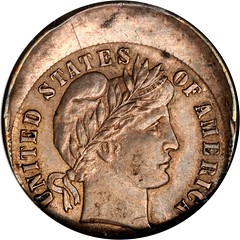

In an informal poll of 127 hobbyists in the spring of 2018, I found that 17 percent consider themselves active or very active collectors of Barber silver coins (constantly upgrading their sets, collecting die varieties by Fivaz-Stanton number, filling albums and folders, and/or active in the BCCS); 21 percent consider themselves casual collectors (collecting the coins but not as their primary interest); 37 percent own some of the coins but don't consider themselves collectors (with more of an accumulation than a collection); and 25 percent don't collect or own them at all. Comments from those polled include:
• "I'm working on a VG set of quarters and halves. They're mostly the first thing I'm looking for, walking into a coin show. One day I'll work on the dimes."
• "I had accumulations of all three denominations once upon a time, focusing on the better dates in Fine to AU. Sold off the halves, then the dimes. Still have the hoard of quarters."
• "I've taken a break recently, but when I'm active it's a sickness."
• "I like them as junk silver. I'd rather have circulated Barber stuff than Washington quarters or Roosevelt dimes."
• "They are attractive in Mint State."
• "Barber dimes mostly, slowly participating in the registry. I only buy a few pieces a year, no rush, just nice pieces when they come available."
• "My halves set is complete and I have done a little upgrading on some of the lower-quality ones. I have always favored the quarters for some odd reason and have been continually looking out for upgrades to my set."
• "Original, attractive circulated Barbers do grab my attention when I see them."
• "Always been fascinated with them, but the higher-quality issues are expensive. I like them in G/VG bulk rolls I can pour out of the tube, like treasure. I do occasionally buy/sell some nice higher-grade PCGS circs, mainly halves."
• "I prefer Mint State, and think there is more value there."
• "I generally prefer circs to MS Barbers, as I appreciate the 'workhorse' aspect of the coins more than the design."
And one very active collector, trying to steer competitors away from "the good stuff," facetiously warned: "Barber material is hideous. Terrible design . . . mundane. Avoid at all costs, especially examples in the VF-EF range."
Research and fellowship continue in the field. Collectors study die states, share photographs of their coins, and keep in touch online and in person. Specialists scrutinize die varieties, and seek out errors and misstrikes, pattern pieces, love tokens engraved on Barber coins, and other byways of the series. This is not a moribund area of numismatics. Researchers such as John Frost continue to unearth fascinating unpublished history. His Charles Barber-related appendix in the new second edition of the Guide Book of Barber Silver Coins marks this research's first publication in book form.
Reading the latest research, hearing feedback from collectors, and surveying the lay of the hobby tells me that Barber silver coins are well known and appreciated. They have a relatively small fan base (compared to, for example, Morgan dollars)-but those fans are very enthusiastic. At the same time, there's still room at the table for newcomers to join the ranks, for casual collectors to become more active, and for everyone to contribute to ongoing research and education. There's much that's new in the second edition of the Guide Book of Barber Silver Coins. There will be even more, when the time comes, in the third.
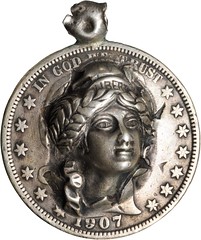

Dennis Tucker is the publisher of Whitman Publishing, LLC; numismatic specialist on the Treasury Department's Citizens Coinage Advisory Committee; and author of American Gold and Silver: U.S. Mint Collector and Investor Coins and Medals, Bicentennial to Date.
A Guide Book of Barber Silver Coins, 2nd edition
By Q. David Bowers; foreword by John Frost
ISBN 0794846386 · 6 x 9 inches, softcover, 400 pages, full color · Retail $29.95 U.S.
URL:
https://www.whitman.com/store/Inventory/Detail/A-Guide-Book-of-Barber-Silver-Coins-2nd-Edition+0794846386

GUIDE BOOK OF MORGAN SILVER DOLLARS HISTORY
Dennis Tucker of Whitman Publishing submitted this overview of the history of the Guide Book of Morgan Silver Dollars. It's a great look back on the evolution of the hobby in the U.S. as well as the changes in numismatic book publishing brought about by technology in recent decades. -Editor
A Brief History of the Guide Book of Morgan Silver Dollars
by Dennis Tucker
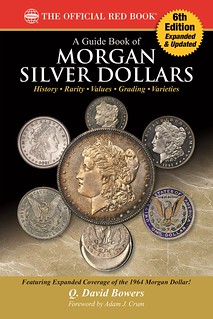 Whenever the classic coins of the United States are ranked for popularity, the famous Morgan silver dollar rises to the top of the list. Every day at
Whitman Publishing we see evidence of its universal appeal. Hobbyists buy thousands upon thousands of coin folders, albums, and other holders to store and
display their Morgan dollars. We get emails, letters, and phone calls about the hefty old coins. When we go to coin shows, collectors and investors are talking
about them. As we work on each year's edition of the Guide Book of United States Coins (the "Red Book"), we hear plenty of Morgan dollar observations
and market analysis from professional coin dealers around the country.
Whenever the classic coins of the United States are ranked for popularity, the famous Morgan silver dollar rises to the top of the list. Every day at
Whitman Publishing we see evidence of its universal appeal. Hobbyists buy thousands upon thousands of coin folders, albums, and other holders to store and
display their Morgan dollars. We get emails, letters, and phone calls about the hefty old coins. When we go to coin shows, collectors and investors are talking
about them. As we work on each year's edition of the Guide Book of United States Coins (the "Red Book"), we hear plenty of Morgan dollar observations
and market analysis from professional coin dealers around the country.
Meanwhile, outside the active hobby community, the Morgan dollar is one of the "rare coins" that even non-collectors are likely to know about. They found one in Grandpa's cigar box, or saw them for sale in an airline in-flight magazine, or maybe spent by cowboys in a saloon in a TV Western.
This is a coin that sparks the imagination. Once it entered the American consciousness it never left.
Given this widespread interest, it's easy for a publisher to answer the question, "Why make yet another book about Morgan dollars?" Quite simply, America's most popular coin deserves as many good books as the hobby community can read and enjoy.
From observing the book market over the past 14-plus years, I believe that a rising tide lifts all ships when it comes to Morgan dollars. Because of the hobby's longstanding interest in these coins, each new volume starts out with the potential of a built-in audience. Of course, to be successful a book has to share valuable information and it helps to be well written. From there the appreciative audience and the evergreen subject combine to create more and more excitement over Morgan dollars.
The First Edition of a New Hobby Classic
Q. David Bowers's Guide Book of Morgan Silver Dollars, billed as "A Complete History and Price Guide" and recently released in a sixth edition, is the most popular reference in the field.
The first edition was published in 2004. By then Bowers was widely recognized as a subject-matter expert (not just on Morgan dollars, but across all aspects of U.S. numismatics). His published work on these coins goes back decades; a short list includes the Comprehensive U.S. Silver Dollar Encyclopedia (1992) and the hugely popular two-volume Silver Dollars and Trade Dollars of the United States: A Complete Encyclopedia (1993), not to mention numerous chapters, essays, and articles published in other books and in hobby journals, newspapers, and magazines.
Updates, and a New Layout
The second edition of the Guide Book followed in 2005 with updated pricing and certified-coin population data. A new appendix studied the Morgan dollar patterns of 1878.
In 2007 we published the third edition. By this time the modern renaissance in numismatic publishing was well under way. No longer were black-and-white photographs acceptable to the hobby community; the third edition of the Guide Book of Morgan Silver Dollars was published in full color. (Yes, nuances of color are noticeable in silver coins; they're not as colorless as a non-collector might think!) Again the book's coin-by-coin pricing was updated, reflecting the ever-changing market, and certified populations captured the latest third-party-grading data. New research was incorporated into the manuscript-Morgan dollars are a robust and very active field of study with new discoveries regularly being made. The book's layout and typography were spruced up to make it as pleasantly readable as possible and easy for the reader to navigate.
Expansion and New Books in the Field
The fourth edition came out in 2012. Again fully updated and revised, the new volume added an illustrated appendix of misstruck and error Morgan dollars, showcasing some truly outlandish coins including double strikes and off-centers, along with insight to guide smart purchases.
What did the hobby community think of Morgan dollars at this point? The fourth edition's updated pricing reflected continuing enthusiasm. Many common dates had increased in retail price by 50 percent or more since the book's first edition debuted eight years earlier, and rare dates and varieties had doubled-or more-in value. The Morgan dollar remained the King of American Coins.
By the time the Guide Book of Morgan Silver Dollars established itself as the coin's modern standard reference, other Whitman books had joined the party. In late 2009 (with a copyright date of 2010) we published Carson City Morgan Dollars: Featuring the Coins of the GSA Hoard, by Adam Crum, Selby Ungar, and Jeff Oxman. "This book begins with the accidental discovery of gold in California in 1848," we announced at the book's release. "The struggles of adventurers in the Gold Rush . . . the Nevada silver boom of the late 1800s . . . the creation of the Carson City Mint . . . these are some of the rich historical veins that Crum, Ungar, and Oxman mine in Carson City Morgan Dollars."
Carson City Morgan Dollars was expanded and revised in a second edition released in 2011, then updated to a third edition that debuted at the American Numismatic Association's National Money Show held in Atlanta in March 2014. Even with its specific focus on a subset of Morgan dollars, there was plenty of new material to justify the new edition. It was updated with additional historical photographs, revisions from ongoing research, new coin values and certified-coin populations, and fresh market commentary.
In November 2012 (copyright date of 2013) Whitman published The Private Sketchbook of George T. Morgan, America's Silver Dollar Artist, a remarkable new book made in cooperation with the Smithsonian Institution. "Today most collectors know Morgan as the father of this legendary silver coin," we noted. "Some specialists are familiar with his designs for commemoratives and medals, and his significant work in U.S. pattern coins. But who exactly was George T. Morgan?
Karen M. Lee, a curator of the National Numismatic Collection housed at the National Museum of American History, finally answers that intriguing question. Introducing Morgan's never-before-published personal sketchbook, and with unique access to family photographs and documents, Lee reveals the man behind the coins. The Private Sketchbook of George T. Morgan is an eye-opening immersion into what Lee calls the designer's 'life of art and labor.'" This book, like the others mentioned here, went on to win literary awards.
Next, in 2014, a new Whitman book was published, authored by Michael "Miles" Standish assisted by the research/writing team of Charles Morgan and Hubert Walker. In Morgan Dollar: America's Love Affair With a Legendary Coin, various sections discuss the United States during the Morgan dollar era; the anatomy of the coin's design; a market study going back to 1946; a year-by-year analysis of the series, including Philadelphia, New Orleans, Carson City, Denver, and San Francisco coins; and Morgan dollar Proofs.
Exciting New Discoveries in the Fifth and Sixth Editions
The fifth edition of the Guide Book of Morgan Silver Dollars featured the requisite updated pricing, a useful new index, fresh illustrations, and the exciting announcement of a startling discovery: information never before published, the story of the 1964 Morgan dollar. This made national headlines, stirred up the hobby's imagination, and got people talking. Could we have expected anything less from the wonderful and legendary Morgan dollar?
The sixth edition, which debuted in March 2019, continues the ongoing exploration, conversation, and fascination with these classic coins. We have dramatically increased our coverage of the 1964 Morgan dollar. A new appendix describes a serious threat to the hobby: counterfeit coins. We've expanded the index, a helpful tool for navigating the book. And again we've updated the coin-by-coin catalog with current pricing and new certified-population data.
The King of American Coins
The Morgan dollar continues to fascinate experienced numismatists and curious laymen alike. It is linked historically to the U.S. Mint's earliest silver dollars, and connected to the modern dollar coins of later generations. If you learn about its history, design, engraving, production, distribution, and market, you get a richly detailed immersion in every aspect of American coinage. The Morgan silver dollar will always be the King of American Coins.
Dennis Tucker is the publisher of Whitman Publishing, LLC; numismatic specialist on the Treasury Department's Citizens Coinage Advisory Committee; and author of American Gold and Silver: U.S. Mint Collector and Investor Coins and Medals, Bicentennial to Date.
A Guide Book of Morgan Silver Dollars, sixth edition
By Q. David Bowers; foreword by Adam Crum
ISBN 0794846424 • 6 x 9 inches, softcover, 320 pages, full color • Retail $19.95 U.S.
URL:
https://www.whitman.com/store/Inventory/Detail/A-Guide-Book-of-Morgan-Silver-Dollars-6th-Edition-+0794846424
THE BOOK BAZARRE
DECEMBER 2018 CHOPMARK NEWS PUBLISHED
The December 2018 issue of Chopmark News has been published. The newsletter of the Chopmark Collectors Club is edited by Colin Gullberg. Here's the table of contents. -Editor
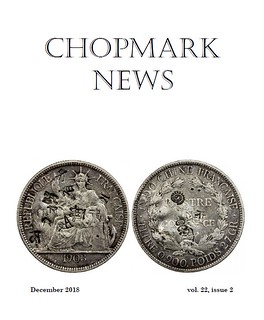 Meet our Members: Bernard Olij
Meet our Members: Bernard Olij
Coins from the Bernard Olij Collection
Coins from Our Members' Collections
Article-Modern Chinese Chop-marked Copper Coins
By: C. Cheung
Article-Philippine Countermark on a Chopped Mexican Pillar Dollar Host: A Collector's Dream
By: E. Yap
Currency Circulation in the Qing Dynasty
Translated by: T. Tseng
Interview: John Lorenzo
For more information, contact Colin Gullberg at:
chopmarknews@gmail.com
NEIL ROTHSCHILD (1956-2019)
Roger Siboni submitted this announcement of the passing of colonial numismatist and coin photographer Neil Rothschild. -Editor
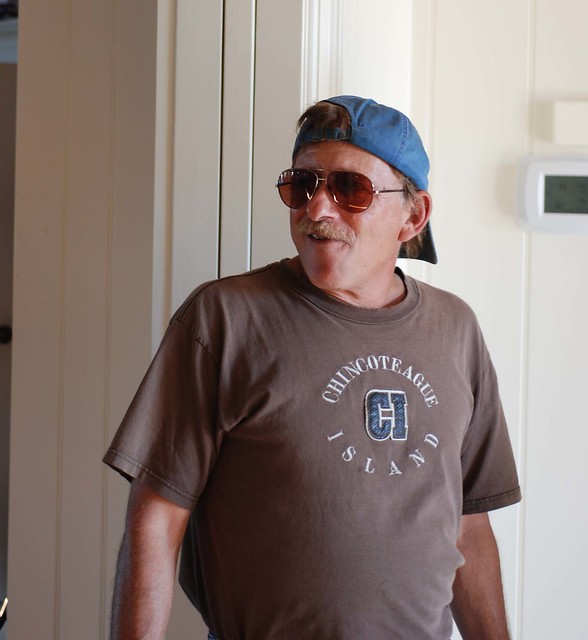 It is with great sadness that I report the passing of our good friend, Neil S. Rothschild (1956-2019). Neil, one of the great scholars of Connecticut
Coppers, passing so closely after his longtime collaborator, Robert Martin, makes this all that much more difficult and sad. Neil was a renaissance man. He
pursued so many directions in life, and in every one he achieved a level of subject mastery and skill. Perhaps that is why over the last few decades we spent
so much time together; there was always something fascinating going on with Neil.
It is with great sadness that I report the passing of our good friend, Neil S. Rothschild (1956-2019). Neil, one of the great scholars of Connecticut
Coppers, passing so closely after his longtime collaborator, Robert Martin, makes this all that much more difficult and sad. Neil was a renaissance man. He
pursued so many directions in life, and in every one he achieved a level of subject mastery and skill. Perhaps that is why over the last few decades we spent
so much time together; there was always something fascinating going on with Neil.
Besides his enormous contributions to numismatics, Neil founded and led his own software company for decades. He was a great birder, taking some of the most amazing shots ever (https://www.pbase.com/nrothschild). Neil was also a seriously accomplished astronomer, specifically an astro-photographer ( https://pbase.com/nrothschild/astro). I can remember one night in particular when he figured out the newly discovered Comet Lulin would be streaking by the New York area. We set up out in my backyard on a cold winter night around 1:00 am -- telescopes, computers, cameras, charts, infra red -- and several curious neighbors looking out their bedroom windows! Neil caught Lulin just as it was streaking by Saturn with its rings on display. The shot was later featured in Sky and Telescope!
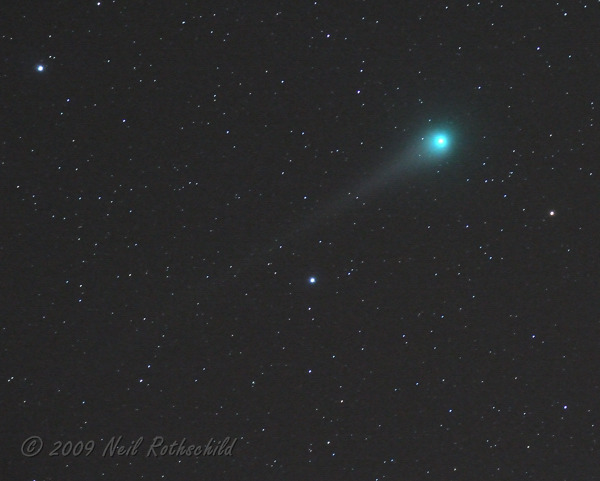
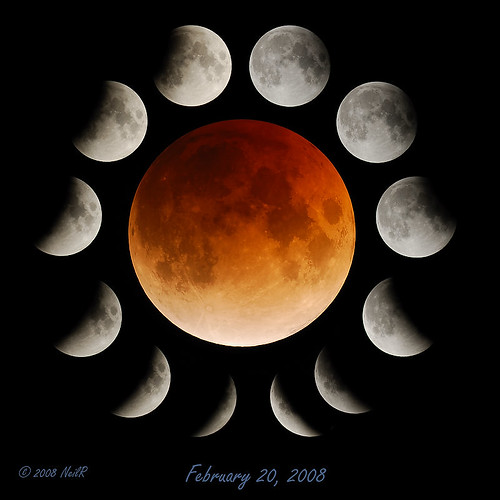 Or the night he caught every aspect of the total eclipse of the moon. Or that one winter that it was so cold that for the first time ever it froze
the lagoon in my backyard "almost" solidly. Neil convinced me to go outside with him and take a walk on it. Jack Howes was having no part of it, so
he took the picture. But later, Neil convinced Jack too (how many times will we get the chance he said?!?!?!?).
Or the night he caught every aspect of the total eclipse of the moon. Or that one winter that it was so cold that for the first time ever it froze
the lagoon in my backyard "almost" solidly. Neil convinced me to go outside with him and take a walk on it. Jack Howes was having no part of it, so
he took the picture. But later, Neil convinced Jack too (how many times will we get the chance he said?!?!?!?).

Roger Siboni and Neil Rothschild
And while Neil was everyone's go-to in the Colonial coin photography world for a few decades, he was everyone's go-to for photography in the Renaissance Fair world, particularly in jousting! I think one of Neil's proudest shots was capturing two mounted jousters, heading full speed at each other. Neil caught the two of them making direct tip to tip contact as the lances exploded into a shower of splinters (https://pbase.com/nrothschild/tip2tip).
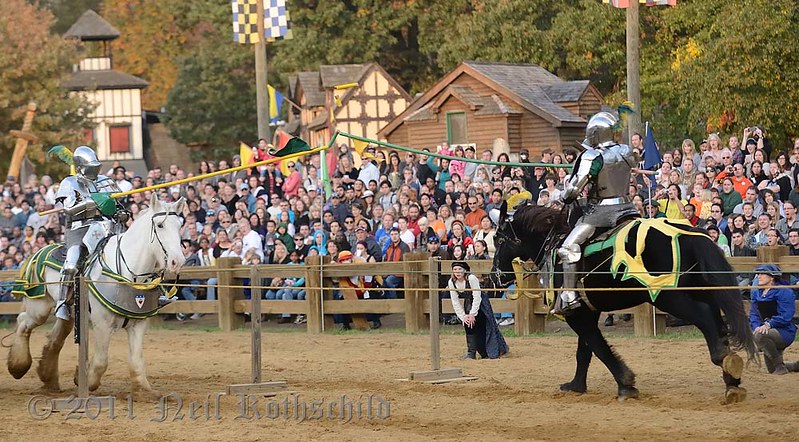
I challenge you to find a Renaissance fair that does not feature one of these images. Neil was also a serious scuba diver, but for health reasons, gave it up in favor of skydiving! So while we have not seen as much of Neil in the past 4 or 5 years as we used to, he was a busy man.
I first encountered Neil in numismatics "virtually" on the old dial-up Comp U Serve Coin Chat Forum that used to meet on Monday nights when I was still collecting Large cents and was just transitioning into New Jersey Coppers. We always seemed to be the first on and the last off and even then started a little New Jersey vs. Connecticut Copper rivalry. Honestly, I would have never imagined back then, living in California, Neil in Baltimore, chatting "online" that we would have ever end up becoming the friends we did. But as we both became more immersed in our respective specialties, Neil had every bit as much passion for Connecticuts as I did for New Jersey Coppers. And he soon set about building digitally what Robert Martin had been doing in analog for the past twenty years!
It is no wonder they would soon meet and collaborate for decades, helping to build each other's massive Connecticut resources for the hobby. But Neil brought one more thing. Like everything else, he would get to know virtually every aspect of everything he got involved with. He understood digital cameras and how they interfaced to a laptop and rendered a digital image better than anyone I ever met -- in Silicon Valley, Tokyo or otherwise. So who else to figure out how to take exact real image shots of dark flat metal discs than Neil?
I remember one week I came back to New Jersey from San Francisco with my brand new, one of the very first, hot off the assembly line, 5th Gen Picture iPods. Neil and I spent the following week taking digital photographs of my collection and figuring out how to download them into my Mac. Transfer them into to the old iPhoto, straining all the technology and very limited memory of that iPod, downloading the images in there and taking my collection in my shirt-pocket to Baltimore. Quite a stir!
Neil was the Colonial collecting community's go to photographer. I would bet more than one in five non-auction house colonial coin pictures in any publication you have seen over the last twenty years was taken by Neil.
Neil was that good. Unfortunately, demand was too high, and Neil was too much of a perfectionist. So output could never keep up with demand and from time to time it frustrated a few. It frustrated Neil too. But how often does perfect come free? We all received so much from Neil.
A brightly burning light extinguished far too soon. But a life well lived. Rest in peace my dear friend.
Jack Howes added this remembrance. -Editor
It was very sad to hear that Neil had died. I had not seen him much in the last couple years as he had become inactive in numismatics.
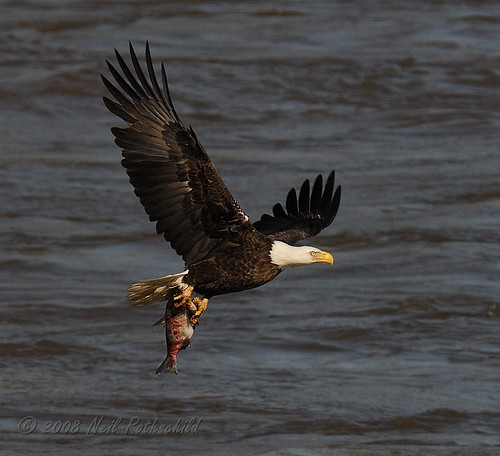 I first met Neil at Roger Siboni's about 15 years ago. Neil was taking pictures of coins with what I thought was very interesting photographic
equipment. He was more than happy to show me what he was doing and tell me why he was using that particular equipment -- Nikon. He was a life long Nikon user.
I still remember those long discussions! Neil taught me all I know about macro photography. But Neil did more than just coin photography. He was an amazing
bird photographer. Among the best I have ever known.
I first met Neil at Roger Siboni's about 15 years ago. Neil was taking pictures of coins with what I thought was very interesting photographic
equipment. He was more than happy to show me what he was doing and tell me why he was using that particular equipment -- Nikon. He was a life long Nikon user.
I still remember those long discussions! Neil taught me all I know about macro photography. But Neil did more than just coin photography. He was an amazing
bird photographer. Among the best I have ever known.
I started using Nikon digital cameras and lenses shortly thereafter. Neil used a 105mm macro lens and a monster light stand for coin photography but he could only get that equipment from one place to another by driving. He claimed that was not really any imposition as he did not like to fly. Which amazed me when at some later point he showed me images of him sky diving!

Sometimes at Siboni's Neil would bring his telescopes -- two Celestrons. And we would be up late into the night using them.
Neil will be missed by everyone who knew him.
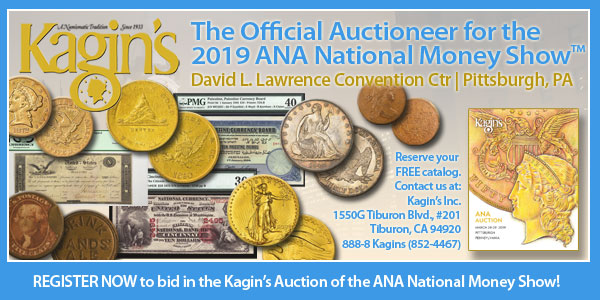
ANN M. ZAKELJ (1947-2019)
Michael E. Marotta submitted this remembrance of his friend Ann M. Zakelj. Thank you. -Editor
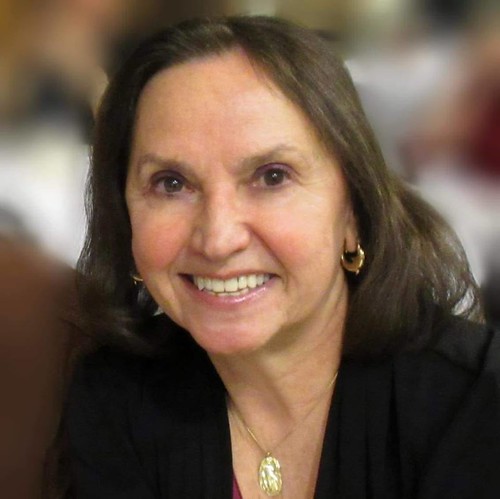 Ann came to numismatics late in life bringing a special passion supported by many years of world travel, a facility for languages, broad reading,
keen insight, and deep reflection.
Ann came to numismatics late in life bringing a special passion supported by many years of world travel, a facility for languages, broad reading,
keen insight, and deep reflection.
We met in Cleveland, Ohio, 1996, when I was a contractor with the U. S. Department of Defense Financial Accounting Service (DFAS). When she handed me her card, I read her name as "Za- kelly." She corrected me. "Zay-kell," she said. "The j is silent." In my cubie, I had a picture of the Greek goddess Eirene carrying the infant Ploutos. Most people assumed that it was the Virgin Mary and Christ Child, but she identified it correctly. It was the beginning of a beautiful friendship. We attended the ANA conventions in Cleveland (1997), Cincinnati (1998), New York (2002), and Pittsburgh (2004).
Ann was very active in her church, St. Vitas, and for them, and others, she crafted proscenia, and other decorations. So, when Ann began collecting ancient coins, her aesthetic judgment always brought her the best examples for the price. Her primary interest was for classical Greek, but she also worked hard on the Severan dynasty, especially the women. Eye-appeal was more important than completeness; and she was an eclectic gatherer, rather than a focused hunter.
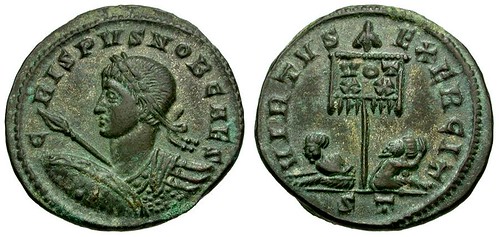
In a casual conversation, we agreed that the coins of Alexander the Great probably portrayed Alexander, and we set out to prove it. We spent over 18 months assembling research, meeting in restaurants, and exchanging information in emails. We published "Portraits and Representations of Alexander the Great," in The Celator, Vol 16., no. 7, (July 2002).
Ann loved to travel and had been to every continent but preferred Europe, especially the Balkans where she had many cousins. Her easy skill with languages served her well. On Rhodes, they thought she was Turkish. In Istanbul, her accent sounded Greek. But it was never a problem because she had a winning personality. She was a natural extrovert and probably got the Sphinx to talk. Ann was born in Austria on March 10, 1947, and passed away peacefully among family, on February 13, 2019.
DR. RAINER OPITZ (1954-2019)
Fritz Rudolf Künker penned this remembrance of Dr. Rainer Opitz. -Editor
"To achieve the possible, we must attempt the impossible again and again." - Hermann Hesse
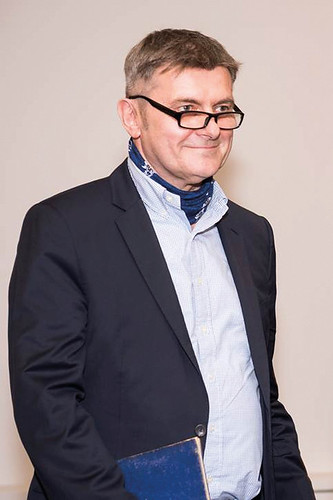 The German numismatic community has lost a visionary: Dr. Rainer Opitz passed away at the age of 64 on February 7, 2019.
The German numismatic community has lost a visionary: Dr. Rainer Opitz passed away at the age of 64 on February 7, 2019.
The businessman Rainer Opitz is known in the numismatic world for his dedication to coins and medals of the history of the Reformation.
For Rainer Opitz, the 500th anniversary of the "Revolution", initiated by Martin Luther's posting of the Theses on the door of All Saint's Church in Wittenberg and the subsequent schism of the Roman-Catholic Church in Europe, remained the pivotal historical event that decisively shaped his life as a collector. Luther and the Reformation massively changed the political landscape in Germany, but also in Europe. The division of the Church was deeply rooted in people's consciousness and the distrust of other denominations has fundamentally influenced societal life, at least in Germany, up to the present day.
The denominational schism was further intensified by the societal changes after the Second World War. The expulsion of Germans from the eastern provinces Pomerania, Silesia and East Prussia, as well as the Sudeten-Germans from Czechoslovakia resulted in an entirely new confrontation in a Germany reduced in size and split into two countries: in the western part, the Federal Republic of Germany was established as a parliamentary democracy; in the east, the German Democratic Republic (which German chancellor Konrad Adenauer often defamatorily referred to it as the "Soviet zone"), was set up as a one-party state, dependent on Moscow, a dictatorship of Stalinist character under the governance of the SED (= Socialist Unity Party).
The economic boom of the Federal Republic of Germany would not have been possible without the new citizens from the east. The intermingling of expellees and "old" citizens nevertheless resulted in numerous conflicts, not least because of the numerous mixed marriages between Catholics and Protestants. It took too long until the positive development of ecumenism began. The issue is as relevant as ever today, seeing as the Roman-Catholic Church finds itself in an existential crisis triggered by countless scandals and crimes of clerics in connection to sexual abuse. The key demands of abolishing celibacy for Catholic clerics and of strengthening the influence of women are extremely important for the Catholic Church today, even though the papacy appears to struggle with accepting fundamental changes. These deep sociological questions were probably something Rainer Opitz pondered along with his enthusiasm for coin collecting.
In a very personal conversation several years ago, he confided in me that he was terminally ill and that the future of his health and personal life was uncertain. He said that was the reason why he decided to have his collection sold by the auction house Künker. It was very important to him that the comprehensive book on his own collection that he initiated would be published by Künker. Unfortunately, he did not get the chance to see the work for himself. It will be published in 2019, which is an honor and the expression of our respect at the same time.
In 2017, Oliver Köpp wrote a portrait about the collector Rainer Opitz in the context of our Auction 297, which shall be republished at this point.
His widow Sabine Reif cited Hermann Hesse in her obituary for Rainer Opitz. The actions and aspirations of Rainer Opitz are perfectly summarized in the quote: "To achieve the possible, we must attempt the impossible again and again." During Rainer Opitz's memorial at the Kunstforum in Potsdam, this motto, which Rainer Opitz used to motivate his employees and friends, was repeatedly emphasized. His strong leadership qualities allowed Rainer Opitz to go far, while never losing his authenticity: 13,000 employees work at his company promota GmbH today.
His social-minded attitude made him a role model in the eyes of his employees. Whenever the demanding and strong-willed businessman and his propensity for discussions strained the nerves of his managers to the breaking point, one fact remained certain for everyone: for Rainer Opitz , it was always about the matter he wanted to promote. He may well have acquired his ascribed leadership qualities during his career in the GDR's National People's Army. After finishing his PhD in philosophy at the Humboldt University in Berlin, he was promoted to the rank of lieutenant-colonel of the NPA during the late stage of the GDR.
Rainer Opitz leaves a big gap in both his family and his company. The world of numismatics will miss the enthusiastic collector who will be remembered through his field of research and collection "Reformatio in Nummis".
Osnabrück, February 28th, 2019
Fritz Rudolf Künker
Here are additional thoughts excerpted from an August 2017 article by Oliver Köpp. -Editor
Rainer Opitz was born in 1954 in the district seat of Sebnitz at the edge of the Sächsische Schweiz National Park. As is the case with most coin collectors, his numismatic interest was stimulated during his youth, when he came in contact with imperial German coins in the possession of his family.
At the age of 14 he did not undergo the "youth dedication", as was customary at that time in the GDR, but rather was confirmed in the German Lutheran church in 1968. One year later the schoolboy acquired his first medal, which was associated with the Reformation. For 5 D- marks, in an Intershop, he bought the copper medal issued by the German Democratic Republic commemorating the 450th anniversary of the Reformation.
In 1981 he had a propitious meeting with the Potsdam numismatist Jürgen Koppatz, author of the book "Banknotes of the German Empire". Koppatz urged Rainer to focus his collecting activity on numismatics involving the Reformation, and to develop a collection concept. In the same year Rainer began a studies program in philosophy with the emphasis "Theory and History of Religion" at the Humboldt University in Berlin, from which he graduated in 1985. From 1987 to 1990 Rainer Opitz worked toward a doctoral degree in the historic relationship between religion and the military, which simultaneously served as the theoretical basis for his collective topic. During this time, the peaceful revolution in the GDR took place and Germany was reunified. In the transition period, Rainer Opitz left his career in science and assumed a leading position with a Bielefeld commercial company.
In 1983 in Zurich, the ca. 1,000-item collection of Prof. Robert Whiting with the theme "Martin Luther and the Reformation in Coins and Medals" was auctioned. The acquisition of the collection catalogue was a landmark experience for Rainer: while the study of the catalogue brought new impulses, his initial euphoria was followed by the recognition that his subject appeared to have already been extensively collected and presented. However, his initial frustration did not last long, for Rainer ascertained that many aspects of the Reformation's minted history were still untouched. This realization spurred the ambitious collector on.
In 2001 Rainer Opitz resigned from his job and founded his own service business. Its economic success enabled him to indulge in his collecting activity to a greater extent, and much more systematically. In the intervening period he had made numerous contacts in the numismatic world, not only to auction houses and coin dealers but to collectors as well, such as Werner Beck of Solingen, with whose support he began to build a library - which is now quite extensive - on "Reformatio in Nummis".
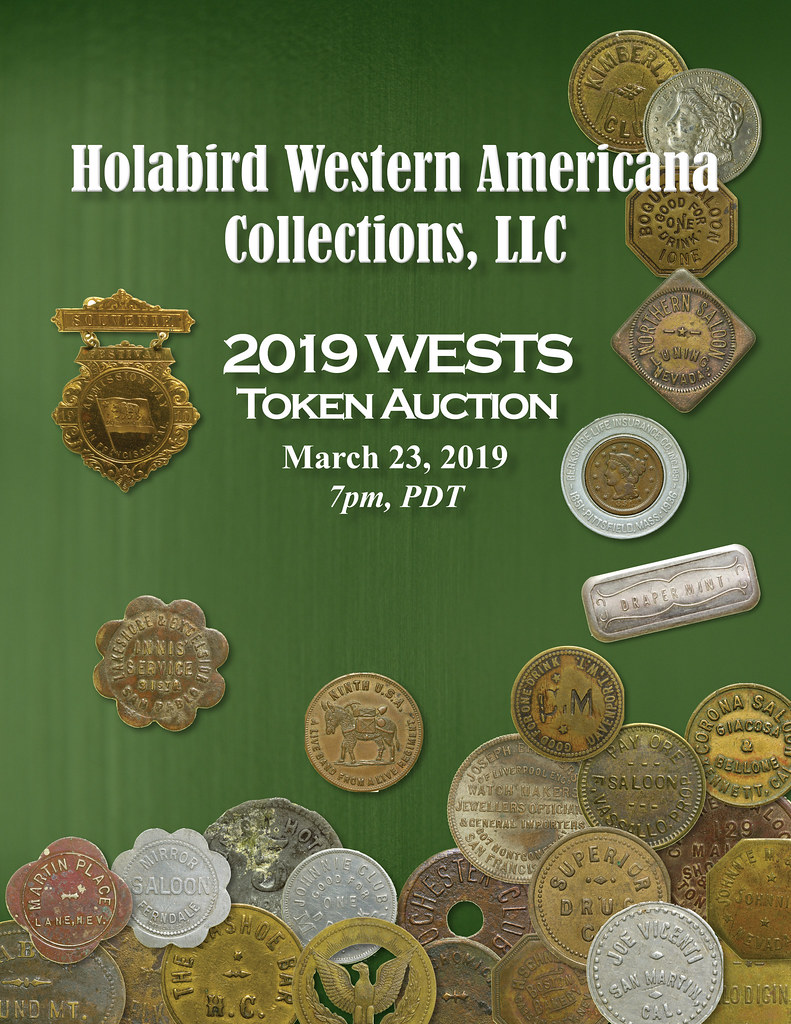
BOWERS RARE COIN REVIEW ON NEWMAN PORTAL
The latest addition to the Newman Numismatic Portal is the Rare Coin Review. Project Coordinator Len Augsburger provided the following report. -Editor
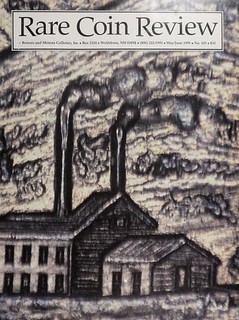 With the kind permission of PCGS president Brett Charville, Newman Portal is pleased to announce the availability of the Bowers & Merena house
organ, Rare Coin Review, on Newman Portal. This publication ran from 1969 (then under the Hathaway & Bowers banner) until 2003, likely the longest
such emission in American numismatic history (Stack's Numismatic Review is also in the running).
With the kind permission of PCGS president Brett Charville, Newman Portal is pleased to announce the availability of the Bowers & Merena house
organ, Rare Coin Review, on Newman Portal. This publication ran from 1969 (then under the Hathaway & Bowers banner) until 2003, likely the longest
such emission in American numismatic history (Stack's Numismatic Review is also in the running).
Rare Coin Review appeared bimonthly for most of its life, and contained feature articles, coins presented at fixed prices, auction previews, and copious commentary from Q. David Bowers on numismatic matters large and small. Sometimes, the small matters were the more interesting! On a personal note, this was the publication that drew the present writer back into numismatics after graduating from college.
Rare Coin Review attracted some of the best writers in the field, as authors were simply more happy to write for Dave than for other editors. The coin offerings were of course the main draw for most readers, and one might find anything from a rare colonial to popular coins like Morgan dollars. There was always something for everyone, from the beginning collector to the specialist, and this was no doubt a great part of its appeal.
House organs such as Rare Coin Review are often overlooked as a source of information, yet they can be a gold mine of valuable data and research. Seen more as ephemeral selling tools, they are read and set aside (or even tossed aside - it takes a dedicated bibliophile to assemble a complete set). Like Len, I became ever-more intrigued with the hobby through RCR articles - in my case, ones on encased postage stamps and merchant counterstamps.
As I grew into a numismatic bibliophile I became fascinated with the house organs of yesteryear such as The Elder Monthly, Mehl's Numismatic Monthly and Kelly's Coins and Chatter, all of which contain interesting and often important information later forgotten by the community at large. Many thanks to PCGS and NNP for making RCR available to collectors and researchers everywhere. -Editor
Link to Rare Coin Review on Newman Portal:
https://nnp.wustl.edu/library/publisherdetail/512756

COMPUTER UNDERSTANDING OF ANCIENT COIN IMAGES
This article describes research at St. Andrews into computer understanding of coin images. -Editor
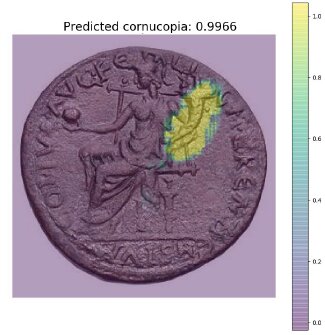 Two researchers at the University of St. Andrews, in Scotland, have recently developed a new machine learning-based method for understanding images
of ancient coins. Their study, pre-published on arXiv applies computer vision and machine learning to ancient numismatics.
Two researchers at the University of St. Andrews, in Scotland, have recently developed a new machine learning-based method for understanding images
of ancient coins. Their study, pre-published on arXiv applies computer vision and machine learning to ancient numismatics.
"My research in this field was a product of bringing two passions together: my ongoing interest in ancient coins (I have a large collection myself) and the state of the art in AI," Ognjen Arandjelovic, one of the researchers who carried out the study, told TechXplore. "In 2010, I wrote a paper on the topic and to my surprise, as this is typically a niche interest, it attracted a lot of attention."
Most previous studies have tried to better understand ancient coins using generic object recognition techniques. Arandjelovic's knowledge and understanding of ancient numismatics, however, led him to believe that these approaches are far from optimal and encouraged him to develop alternative methods. Over the past decade or so, he has published a series of papers that deviate from the aforementioned pattern.
Most existing state-of-the-art methods for the analysis of ancient coins have been found to perform rather poorly. In their study, Arandjelovic and his colleague Jessica Cooper set out to develop a more effective approach, which can describe a coin like a human would to another human.
"The work with Jessica came from my realization that the field has been taking a very wrong angle of trying to determine whether two coins are the same," Arandjelovic explained. "The reason for this stems from the fact that few ancient coin types (relative to the tens of thousands minted during the five centuries of Roman Empire) which has been imaged is rather small, making the approach of little practical importance. Jessica and I thus thought that it would have been much better if the computer could describe the coin, much as a human would to another human."
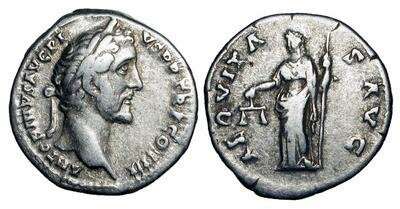
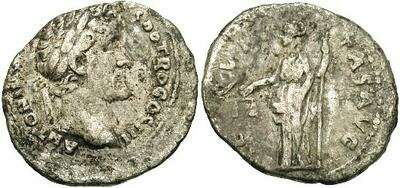

Three very different specimens of the same coin type
"I'm broadly interested in algorithms that mimic the way humans approach tasks," Cooper told TechXplore" When an expert describes an ancient coin, she identifies artistically depicted concepts in the same way that our system does - by recognising shapes in the image. She is also capable of pointing to the elements she is describing: 'there is a cornucopia', 'there is a shield' etc. Our system also does this."
In-depth descriptions are a crucial part of numismatics literature, thus uncovering detailed information about coins using machine learning techniques could prove to be very useful. Coin descriptions are currently written by human experts, which can be quite time consuming. The new method developed by Arandjelovic and Cooper could help to speed up the analysis of ancient coins, automating a significant part of it.
The researchers evaluated their method on the largest existing dataset of ancient coins, which includes coin images extracted from 100,000 auction lots. Their tests yielded highly promising results, with their algorithm making correct associations and accurately identifying semantic patterns in ancient coins.
"We have several plans for future research," Arandjelovic said. "Firstly, we plan to directly continue this research, as we would like to have a system that quite literally describes an image of a coin, using full, proper sentences, just like those that you would see describing coins when they are sold at auctions. We would also like to develop methods that monitor online auction sites to detect stolen coins or fake coins."
This sounds like a very promising avenue of research. It's a big, complicated problem. I wouldn't expect practical applications anytime soon, but I'm glad to see people working in this area. -Editor
To read the complete article, see:
A new method for understanding ancient coin images
(https://techxplore.com/news/2019-03-method-ancient-coin-images.html)

IDENTIFYING THE RECIPIENT OF AN AWARDED MEDAL
Jerome Nashorn of Burke, VA writes:
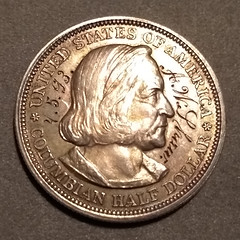 As a medal collector who particularly enjoys acquiring awarded medals and researching the individuals whose names are engraved on them, I enjoyed the
article concerning the engraved Columbian half. However, I am dubious that Mr. Bachman has found the A.W. Shaw who originally owned the coin. Shaw is a
relatively common name and the only other information we have are initials, not even a full first name.
As a medal collector who particularly enjoys acquiring awarded medals and researching the individuals whose names are engraved on them, I enjoyed the
article concerning the engraved Columbian half. However, I am dubious that Mr. Bachman has found the A.W. Shaw who originally owned the coin. Shaw is a
relatively common name and the only other information we have are initials, not even a full first name.
I only feel confident that I have correctly identified the recipient of an awarded medal if the inscribed portion of the medal includes such information as the recipient's occupation or place of residence or name of his/her school or college and, of course, that information must match or be consistent with what I have discovered about the likely recipient from such sources as city directories, census records, school and college alumni directories, military service records, and newspaper articles. It also helps if the recipient has an uncommon first or last name. Fortunately, huge amounts of information are available online at no cost (e.g. from familysearch.com) or online at local public libraries.
To avoid the disappointment of purchasing an awarded medal and then being unable to find out anything about the recipient, I try to do a little preliminary research before making a purchase and only if I am pretty sure I have found the right person do I buy or bid on an awarded medal unless the medal's other attributes are such that I will be happy with it even if I can never an identify the recipient with any certainty.
Mr. Bachman has acquired a nice example of a historically significant coin that has the added attribute of having an attractive addition made by or for someone who obviously treasured it for many years. A good find for sure regardless of whether or not the original owner can ever be identified.
All quite true. Without any accompanying documentation or more information from the coin itself it's very hard to make a solid determination. Shaw is indeed a common name, but these Michigan towns were small and a check of the city directories might reveal only one A. W. Shaw. Still, the fact that the coin was found in that area is circumstantial and it could have originated from anywhere. It's a big country with a lot of potential A. W. Shaws. As Jerome notes, it's a nice piece regardless. -Editor
Tim Bachman adds:
It is true, it's all circumstantial evidence. From the info I have found, I am still hopeful that a solid piece if evidence might emerge. It's a long shot that I will ever find concrete proof that it belonged to him. From all of the searches that I have entered on A. W. Shaw's that were alive in that time frame, I only found 1 other who was alive in 1893, and he was much older, and lived in California. I still have some digging to do, but it's a lot of fun.
To read the earlier E-Sylum article, see:
QUERY: A.W. SHAW ENGRAVED COLUMBIAN HALF
(https://www.coinbooks.org/v22/esylum_v22n11a11.html)
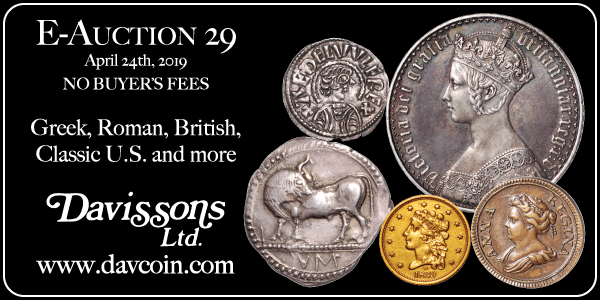
NOTES FROM E-SYLUM READERS: MARCH 24, 2019
The E-Sylum Dazzles
Nick Graver writes:
I sent a photo historian in Boston your latest issue, since it features a Massachusetts article. And I wanted to dazzle him with it.
He could not imagine doing such a publication weekly. And for over twenty years was unreal.
Thanks for enabling me to dazzle such people.
To read the earlier E-Sylum article, see:
HOW COLONIAL MASSACHUSETTS CREATED MONEY
(https://www.coinbooks.org/v22/esylum_v22n11a29.html)
Query: Maris Sale Fugio Cent Die
Craig Sholley writes:
John Dannreuther and I wondering if Lot 628, the Fugio die, from Chapman's 11/16 -17 1900 Maris sale is plated.
Can anyone help? -Editor
Fippence and Fippenny in England and Canada
Ed Hohertz writes:
Some further definitions of fippenny etc. that can be traced back to 1607.
Ed provided these definitions. -Editor
From: Merriam-Webster
Definition of fippenny bit: a Spanish half real piece : a silver coin worth 1/16 of a Spanish dollar that circulated in the eastern U.S. before 1857 and
passed current for about six cents
- called also fip, fourpence ha'penny, sixpence
From: The Oxford Universal Dictionary on Historical Principles, 3rd edition 1955, p702: Fip. U.S. 1844 [short for fippenny bit];
Fippenny Bit, or contracted, Fip, fivepence. "In Pennsylvania . . the vulgar name for the Spanish half-real." Taken from John Bartlett's Dictionary of Americanism (1848, etc., 1876).
Fippence. 1607. [Corruption of five pence.]
From: Dictionary of Americanism, John Bartlett, 1848, p139:
Fippence, for fivepence, is also provincial in England.
From: Dictionary of Numismatic Names, Albert Frey, 1973 reprint, p84:
Fip. A corruption of fipny bit, i.e., a five-penny bit. It was used in the Eastern Middle States for the Spanish Medio or half Real.
Paul R. Petch writes:
Being a Canadian, the terms fippence, and its close associate fippenny, are new to me. It is possible that that there were some early Canadians, probably of British origin, who used these terms to refer to our five-cent denomination. This would justify Appleton's New English-Spanish, Spanish-English Dictionary believing them to be Canadian terms.
However, more astute than Appleton is the Oxford English Dictionary. The OED does not list fippenny, but fippence does appear as a colloquialism and corruption of five pence, which certainly does make sense. More than this, and in the thorough style of the OED, historic uses of the term are:
1607 R. C. World of Wonders 50 Women gorgeously apparelled, finicall and fine as fippence.
1721 J. Kelly Scot. Prov. 18 As fine as Fippence, you'll give a Groat raking.
1823 Blackw. Mag. XIII. 457 On leaving the lush-crib, we can figure them giving fippence to the drawer
To me, this firmly establishes fippence as a term used in England and not extensively in Canada.
Thanks, guys. -Editor
To read the earlier E-Sylum article, see:
CANADIAN FIVE CENT TERMS: FIPPENCE, FIPPENNY
(https://www.coinbooks.org/v22/esylum_v22n10a25.html)
The Banquet de Lille
Regarding John Linhoss' question, John Lupia writes:
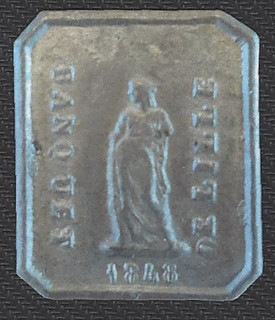 I saw the so-called Mystery Token Banquet de Lille which is typically a tin medal made in 1848 at Lille, France, and there is one in the collection
of the Musée Carnavalet, Histoire de Paris.
I saw the so-called Mystery Token Banquet de Lille which is typically a tin medal made in 1848 at Lille, France, and there is one in the collection
of the Musée Carnavalet, Histoire de Paris.
Thanks. John provided this link for more information. -Editor
To read the earlier E-Sylum article, see:
Banquet de Lille, 1848
(http://parismuseescollections.paris.fr/fr/musee-carnavalet/
oeuvres/banquet-de-lille-1848-1#infos-principales)
To read the earlier E-Sylum article, see:
NOTES FROM E-SYLUM READERS: MARCH 11, 2019 : Mystery Token - Communion Token?
(https://www.coinbooks.org/v22/esylum_v22n11a12.html)
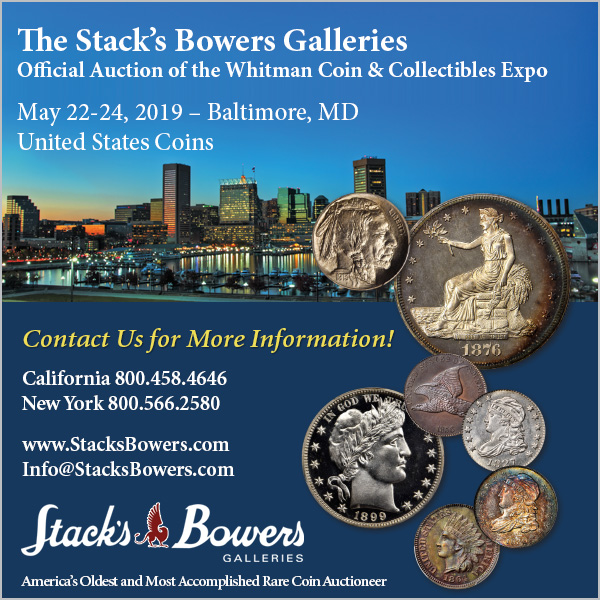
HARVEY STACK RECALLS KRAUSE PUBLICATIONS START
Harvey Stack submitted these recollections about the founding of Numismatic News, the flagship publication of the Krause Publications empire. -Editor
It was so sad to read that F & W publications had to declare bankruptcy.
The growth of numismatic papers after the second World War, was developed by Chet Krause in the later part of 1950 or early 1951
I met Chet during this early period when he came to visit my Uncle Joseph who was one of the senior members of Stack's at that time. Both Chet and Joseph became friends on the road,while attending coin shows all over America.
Chet came in to visit us at that time,when I first met him, to discuss the growth of numismatics with my uncle.
Chet started the chat with a question. " Joe" he said, I am in the printing business, as you know , in Iola, Wisconsin. Having visited many coin shows and convention, I am of the opinion that numismatics is growing, especially since the Mint is continuing making Commemorative Half Dollars, and also is striking some 50,000 Proof sets again, since 1950. A great increase since 1942 , when they ceased to making Proofs because of World War II. I feel that the hobby has been revived somewhat, the economy is getting better, people are starting to collect again, and since most publications are monthly issues, the information to help people learn and become aware of the market for coins, is needed, and a weekly paper , sent by mail to subscribers will help the hobby continue to grow. So, Joe, I plan to start a weekly publication with Coin Information in it, and hope to create a larger market for Numismatics."
"However , Joe, that's why I am here.I admire the way your firm has grown, and the activity I see in your shop with collectors of all ages, and know how you have grown, and have the experiences that could guide me to go ahead !!!"
"So Joe, I came to ask you, since you are so well versed in the hobby, have had responses of great note, not only for your retail and mail order business, but have conducted many of the important sales for the last decade or more, WHAT DO YOU THINK ? AM I CRAZY TO TRY TO PUBLISH COIN INFORMATION ON A WEEKLY BASIS, TO COMPETE WITH THE FEW PUBLICATIONS THAT PUBLISH ONCE A MONTH, AND EVEN THE ANA 'Numismatist" only comes out monthly, do you think I am right to go weekly ?"
My uncle, while I was listening to this conversation, jumped out of his chair and reached his hand out to shake Chet's and shouted, " Chet, you are going to be a Godsend for the hobby. A weekly publication will keep people interested more so in the hobby, give them news that is not month's old, and I feel that you will be the best ' SHOT IN THE ARM' for the hobby !"
"Wow. Joe, you are very encouraging and I am happy I came in to discuss this with you. Joe, on your recommendation, I plan to go ahead, and thank you for the encouragement you gave to me "
That to me was watching history about to happen.For over a half a century, NUMISMATIC NEWS was published weekly, had a great audience for decades, and I was there when "history was made"
So to see a numismatic publication, possibly cease to exist, is very heart sickening for me, and I am sure the others who remember back to the birth of a weekly publication will feel as sad as I do right now.
Maybe Numismatic News, and the other books and references published out of Iola will be taken over and become once again an important asset to the Numismatic World.
I would hate to see it die, like other publications I witnessed in the past, and surely not want to see it just fade away, for it was confirmed to start at Stack's and like Stack's Bowers now, I would love to see it continue.
Harvey G. Stack
Co Founder, Stack's Bowers
Thanks, Harvey.
I feel strongly that the Krause numismatic businesses can be revived, but it would take a strong commitment to return to basics. Ridding itself of debt is only the first step. Go back to the kitchen table where Chet Krause started Numismatic News, and start over. Today's technology is a must, but are pricey high-end New York Times style systems the only solution? Auction houses certainly need that level of technology today, and the expense of these systems is what has driven consolidation in the business.
But publishing doesn't have to be that complicated. I started The E-Sylum as a one-man effort and with a couple part-time helpers today we publish some thirty articles a week. Owen Linzmayer is a one-man publisher with The Banknote Book world paper money catalog. Our products are high-quality and sought after by readers. Hopefully all the Krause numismatic publications will find good new homes with owner-operators who care about their niche and community, and work hard to rebuild sustainable businesses.
The comment from one of F + W's managers ("I built the NY Times website, I know what I'm doing.") came to mind this week as I was reading about systems theorist John Gall. -Editor
Gall spent forty years pediatrizing in private practice. Along the way, he published several books about systems: what makes them work and why they fail. I learned about Gall through the Law he coined:
A complex system that works is invariably found to have evolved from a simple system that worked. A complex system designed from scratch never works and cannot be patched up to make it work. You have to start over with a working simple system.
Gall's Law explains why imitating winners is a trap. The complex systems that work for someone at the peak of their productivity and success evolved from simple ones over time. Adopting these methods at the beginning of your own journey "never works and cannot be patched up to make it work."
Shun complexity. If you're writing your first or second book, you need "a working simple system" for organizing your ideas and getting words on the page. If you're starting a podcast, buying the same high-end rig some NPR alum uses in their home studio is just going to slow you down. In the words of computer scientist Donald Knuth, "premature optimization is the root of all evil." This applies just as much to book outlines as it does to blueprints.
To succeed, start with the simplest possible system: butt in chair. Let it evolve from there.
To read the complete article, see:
the only system that works
(https://mavengame.com/2019/03/the-only-system-that-works/)
To read the earlier E-Sylum article, see:
KRAUSE PUBLICATIONS PARENT FILES FOR BANKRUPTCY
(https://www.coinbooks.org/v22/esylum_v22n11a07.html)

VOCABULARY TERMS: INSCRIPTION
Dick Johnson submitted this entry from his Encyclopedia of Coin and Medal Terminology. Thanks! -Editor
Inscription. The lettering on a coin or medal usually appearing horizontally across the field, or upon a figure or device, but in the broadest sense lettering in any position on a numismatic item. It differs from legend which is lettering following the circular contour of the round coin or medal; and exergue, the lettering in this area below the base line. Also vertical inscription exists - lettering which appears vertical to the base line - (or even a wavy inscription with an undulating base line). The study of inscriptions on numismatic items is a branch of epigraphy; the lettering on coins and medals is of vital importance, just as is lettering on monuments, temples and buildings is valuable documentation to historians.
Inscription Content. Inscriptions are dramatically related to the space available in a coin or medal's design. They are abbreviated, or shortened, to fit a tight space -as for most coins - or occasionally expanded for larger medals (words added or lettering made larger). Inscriptions often contain numbers, as dates (either Arabic or Roman), a monarch's number (most often Arabic). Dates of coronation, inauguration, founding dates, or completion date of some public project, all are found as inscriptions. (See dates and dating.)
Often the text of an inscription is composed of mottos, or quotes, as from the Bible, Shakespeare, or prominent authors or poets. (Parts of poems are sometimes inscriptions, in fact the German language has a word for a rhyming inscription on a coin or medal, seligkeitsthaler.)
Inscription characteristics. For the most part inscriptions identify the person or event portrayed in the design and reinforces this by title, date or both. Inscriptions are not captions, like the description of the picture portrayed, but rather they are an integral part of the total design. Inscriptions reveal in words the essence or concept of the piece, what the device reveals in design.
The lettering of inscriptions on coins and medals is almost always in caps, from the tradition of Greek and Roman inscriptions. The shape or typeface of the lettering is, or should be, in harmony with the style of the device. See lettering.
For nearly 2,000 years lettering was formed on coins and medals - at least those that are struck - by punches. A die would be engraved with the device and the lettering would be punched in afterwards to complete the die. See punches, puncheons. (Since 1900 most dies are made from patterns in which both device and lettering, all raised and sunken relief are in the pattern and replicated into the die.)
Varieties in inscriptions. More variations are found in lettering than in devices and other pictorial elements in coin and medal designs. Separate letters, particularly with punches, present more opportunity for an errant letter to be used. Errors of spelling are called blundered inscriptions. These are often corrected causing two die varieties of the piece.
Dates in inscriptions are sometimes corrected - or updated - and titles are infrequently changed for the monarch or person portrayed. In numismatics, examination of inscriptions is very important for identifying varieties.
Cataloging inscriptions. Every letter, punctuation and stop (typographical ornament) should be recorded when cataloging inscriptions. Record exactly every letter and digit; if the numismatic item bears IIII do not record IV. Follow foreign language exactly. Identify any errors in either spelling or letter defects, as upside down punch, for example. (Broken serifs on punches are even cataloged but only for identifying minor die varieties.)
A most important rule: Identify the language of the inscription and translate it into the language of the main text.
Inscriptions sometimes appear on coats of arms, shields, or other objects in the design. These should be identified in the description (but are usually not indexed).
Indexing inscriptions. When indexing inscriptions, alphabetize by first words; omit the articles "a" and "the" at the beginning only (record all letters but include all articles afterwards); disregard spaces between words and all numbers (both Arabic and Roman). Indexing by computer will include the spaces, so some adjustment may be necessary after the computer sorts inscriptions alphabetically.
Foreign language inscriptions are indexed exactly as they appear on the numismatic item. Long inscriptions (as a typographic reverse) may be indexed by first words but may be shortened to the first line or two (then adding an ellipse, "..."). This eliminates the need to record the entire lengthy inscription in the index.
Some European numismatic catalogs index all the cataloged items by their inscriptions - so important is it considered in European numismatic and medallic art. For some reason such an index seems less important to Americans.
References:
NE42 {1982} Doty, p 125 (epigraphy), 178-179 (inscription).
NC8 {1988} Breen, p 5-7 (Colonial inscriptions).
N19 {1993} Mackay, p 51-77.
Some Interesting Inscriptions On Coins
AUCTORI VERMON [Auctoritate Vermontensium]
By authority of the Green Mountain People
(Vermonters) on Vermont Coppers (1785-89).
D'VLUGTENDE AMERICAANES VAN ROHDE YLAND
The fleeing Americans of Rhode Island on
Rhode Island Ship Tokens (1779).
HONI SOIT QUI MAL Y PENSE [motto Order of the Garter]
Shame on whoever thinks ill of it on Jacob's
Theater of New York Penny (1796), foreign coins.
Looking for the meaning of a numismatic word, or the description of a term? Try the Newman Numismatic Portal's Numismatic Dictionary at: https://nnp.wustl.edu/library/dictionary
Or if you would like a printed copy of the complete Encyclopedia, it is available. There are 1,854 terms, on 678 pages, in The Encyclopedia of Coin and Medal Technology. Even running two a week would require more than 19 years to publish them all. If you would like an advance draft of this vital reference work it may be obtained from the author for your check of $50 sent postpaid. Dick Johnson, 139 Thompson Drive, Torrington, CT 06790.
SIEGMUND KOHN HARZFELD (1848-1883)
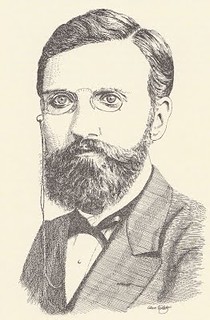 Siegmund Kohn Harzfeld (1848-1883), was born on December 30, 1848 at Kassel, Hesse, Germany, son of Bernhard Simon Kohn Harzfeld and Hannchen Kohn
Harzfeld.
Siegmund Kohn Harzfeld (1848-1883), was born on December 30, 1848 at Kassel, Hesse, Germany, son of Bernhard Simon Kohn Harzfeld and Hannchen Kohn
Harzfeld.
On March 25, 1874, he married Amelia Bernheimer (1853-1931) at Wiesbaden, Germany. They had five children : Emmanuel Harzfeld (1872-1872), Johanna Harzfeld (1874-1934), Emmanuel Harzfeld (1876-), Benjamin Harris Kohn Harzfeld (1880-1921), and Henry Harzfeld (1881-).
He came to America in 1876. He published sixteen coin auction catalogues in his 39 month coin career at Philadelphia. He published his Harzfeld's Numismatic Circular beginning in April 1877.
He printed his advertisements on the blank side of uniface obsolete bank notes.
In October 1877, he published his first coin catalogue of a foreign collection of the late Georg Friedrich Grotefend (1775-1853) : Catalogue of coins and medals, comprising Greek and Roman coins, etc., from the renowned collection of Dr. Grotefend, Hanover, Germany
He was familiar with U. S. Mint employees and through his interactions led him late 1878 to become a strong critic of U. S. Mint practices.
He discovered 150 1879 Stella $4 gold pieces still kept in the U. S. Mint, which he acidly asserted were available to concubines but not to collectors. Snowden granted Harzfeld a private interview showing him orders received for the coins, but no retraction seems to have appeared.
In 1879, he published an 8-page pamphlet On the falsification of ancient coins.
He was a member of the Numismatic and Antiquarian Society of Philadelphia. He wrote in Numisma, September (1880) "Officials" of the Mint, writing against Mint Superintendent Snowden and former Mint engraver Eckfeldt's Theodore for illegally selling restrikes of the 1804 Dollar.
Harzfeld introduced American numismatists to the truth regarding some European coins and medals. Among these we find the 1862 so-called Janauschek Thaler, which previously was claimed to be bearing the portrait of the actress Franziska Magdalene Romance Janauschek (1829-1904).
He also served as the sole agent for sales of Lea Ahlborn's medal of Joseph J. Mickley, and William H. Key's medal of Hon. Eli Kirk Price, president of the Numismatic and Antiquarian Society of Philadelphia. Key also struck a Washington medal for Harzfeld for his series of medals known as "Harzfeld's Series".
In 1878 he lived at 1713 Park Avenue, Philadelphia, Pennsylvania.
In the Janesville Gazette in January of 1879 he was cited as owning a 1793 Large Cent in uncirculated condition valued at $100.
In 1879, he published his Fixed Price List (FPL) titled "Old Coins and Their Values. Catalogue of American and Foreign, Ancient and Modern Coins, Medals, Etc. and the Prices at Which They May Be Obtained. An Indispensable Guide To Every Coin Collector."
His 1880 U. S. Census listing reports his occupation as a professor of Numismatics.
Harzfeld suffered from frail health and returned to Germany,
The October 1882 issue of the American Journal of Numismatics reports receiving a letter from Harzfeld who was convalescing in Wiesbaden, Hesse, Germany, saying his health is improving.
He died on December 18, 1883 at Wiesbaden, Hesse, Germany.
To read the complete article, see:
HARZFELD, SIEGMUND KOHN
(https://sites.google.com/a/numismaticmall.com/www/numismaticmall-com/harzfeld-sigmund-kohn)
The entire inventory of the Lupia Numismatic Library is for sale. Individual items will be available before the remaining archives are broken up into parcels sold at philatelic auctions in the U. S. and Hong Kong. Check NumismaticMall.com frequently as dozens of new items with estimates will be posted daily until everything is sold.
All inquiries will be given prompt and courteous attention. Write to: john@numismaticmall.com .

2019 PITTSBURGH NATIONAL MONEY SHOW HIGHLIGHTS
This ANA press release highlights events at next week's National Money Show in Pittsburgh. I'll be in town for a couple days and hope to see a number of E-Sylum readers, contributors and sponsors there. -Editor
Pittsburgh National Money Show Awaits Collectors
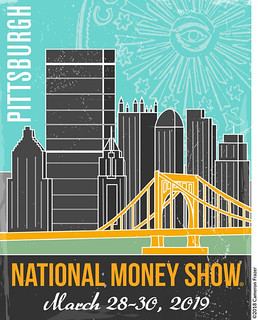 Coin collectors are enthusiastically anticipating the National Money Show in Pittsburgh, March 28-30. The three-day event, sponsored by the nonprofit
American Numismatic Association, is expected to attract thousands of coin collectors from Pennsylvania and throughout the U.S. eager to buy, sell and see more
than $100 million of historic numismatic treasures.
Coin collectors are enthusiastically anticipating the National Money Show in Pittsburgh, March 28-30. The three-day event, sponsored by the nonprofit
American Numismatic Association, is expected to attract thousands of coin collectors from Pennsylvania and throughout the U.S. eager to buy, sell and see more
than $100 million of historic numismatic treasures.
Nearly 200 coin dealers will be on hand offering the finest numismatic inventory available; the U.S. Mint also will be in attendance with numerous popular products. Many of the numismatic experts present will provide free, informal evaluations of the public's old coins and paper money. Kagin's, the official auctioneer of the show, will conduct a three-session live auction featuring a diverse selection of U.S. coins, world banknotes and U.S. currency. A plethora of educational presentations, family activities and fascinating exhibits round out the happenings.
Show hours are 10 a.m. to 6 p.m. on Thursday and Friday, Mar. 28 and 29, and 10 a.m. to 4 p.m. on Saturday, Mar. 30. ANA members can enter the show 30 minutes before the public. Last admission is 30 minutes prior to closing. Admission is $8 for adults, but ANA members and children 12 and under are always free. The event will take place in Hall B of the David L. Lawrence Convention Center.
For up-to-the-minute show information visit money.org/NationalMoneyShow .
LEARNING EXPERIENCES AWAIT COLLECTORS
For more than a century, the ANA has offered the finest numismatic education in the hobby, which continues in Pittsburgh with free hour-long Money Talks lectures. These presentations cover a variety of numismatic topics and research. Presentations take place Thursday and Friday, Mar. 28-29 from 10 a.m. to 3 p.m.
• Steering the Course of the Hobby's Flagship Publication - Barbara Gregory, Thursday at 10 a.m.
• Civil War Storecards: Latest Research and New Finds Since the 3rd Edition - Mark Gatcha, Thursday at 11 a.m.
• Lewis and Clark's Impact on U.S. Coinage and Currency, and Pittsburgh's Role in this Historic Expedition - Rob Throckmorton and Richard Gaetano, Thursday at 12 p.m.
• Money of Empire: Elizabeth to Elizabeth - Douglas Mudd, Thursday at 1 p.m.
• Seige Note: The Currency of War - Lawrence C. Korchnak, PhD., Thursday at 2 p.m.
• Strategies to Dispose of Your Collection - Rod Gillis, Thursday at 3 p.m.
• What's In Mickey's Pocket: Disney Dollars - Paige Price, Friday at 10 a.m.
• Don Everhart: A Career in Coin Design - Don Everhart, Friday at 11 a.m.
• Rex Magnae Britanniae: The Final Coinage Reform of James VI of Scotland - E. Tomlinson Fort, Friday at 12 p.m.
• Future Trends of Traditional Coin Collecting in Modern China - Leo Wang, Friday at 1 p.m.
• Astrological Calendar Medals of the Vienna, Austria Mint - Simcha L. Kuritzky, Friday at 2 p.m.
• Never Say "Banal" Objects: Tokens and Erotic Tesserae from Hellenistic and Roman Sicily - Antonino Crisà, Friday at 3 p.m.
The Legacy Series acquaints collectors with the legends, heroes and icons of numismatics. Moderated by Barbara Gregory, editor-in-chief of The Numismatist, this year's Legacy Series recognizes Don Everhart, former U.S. Mint lead sculpture and engraver. The interview takes place on Thursday, Mar. 28 from 3 to 4 p.m. in Room 414 of the David L. Lawrence Convention Center. Admission is free, but space is limited. Call 800-514-2646 to reserve a seat.
FAMILY-FRIENDLY EVENTS AND HIGHLIGHTS
• Coin-Collecting Basics: Saturday, Mar. 30, 12 p.m., Room 412 - This class covers the nuances of coins and paper money, and shares tips on how to collect smart.
• Coin Collecting 101: Thursday-Friday, Mar. 28-29, 10 a.m. and 2 p.m., Table 732 - Informal 30-minute discussions are intended for the numismatic newcomer, offering an introduction to the hobby and how to assemble a great collection.
• Young Collectors Corner: A Workshop for Children: Saturday, Mar. 30, 9 a.m. to 11 a.m. (check-in starts at 8:30 a.m.), Room 406 - Experienced numismatists share basic information about the hobby, including coin identification and production. Scouts are required to wear their uniforms to be eligible to earn the "Coin Collecting" merit badge or the "Fun with Money" patch.
• Treasure Trivia: Thursday-Saturday, Mar. 28-30, Table 732 - Families and children learn about numismatics as they explore the bourse floor in search of answers to trivia questions. This free game is scheduled during public show hours.
SPECTACULAR EXHIBITS
Show attendees have the opportunity to see some of the world's most beautiful and valuable coins, paper money and related numismatic treasures not seen anywhere else. Collector-produced exhibits are among the most popular features at every show, with individual creativity rivaled only by the quality and variety of the items on display. The Museum Showcase features rare and historic items from the ANA's Money Museum in Colorado Springs, Colo., and includes:
• The 1804 Draped Bust U.S. Silver Dollar: The "King of U.S. Coins" is one of only 15 known examples and is insured for $4 million.
• The 1913 Liberty Head Nickel: One of five known 1913 Liberty Head nickels made under mysterious circumstances at the Philadelphia Mint.
• Bebee Error Notes: Rarely seen specimens from the famous Bebee collection of paper currency and uncut notes.
• A 1933 $10 Eagle: In March 1933, President Franklin Roosevelt halted the release of gold coins from the Mint to help reverse the tide of the Depression. This act created noteworthy gold coin rarities, including the spectacular 1933 eagle.
• The 1943/44 Cent Case: In 1943, to save copper for World War II, the U.S. Mint produced Lincoln cents using steel instead of the normal bronze alloy. A few 1943 Lincoln cents were mistakenly made from left over 1942 bronze blanks instead of the zinc-coated steel creating an instant sensation. The same accident occurred in 1944 when the Mint returned to bronze cents - a few of the steel cent blanks were struck as 1944 cents. On display courtesy of the Dazzling Rarities Collection.
FOOD, FUN AND FELLOWSHIP
Show attendees are invited to join the National Money Show's host organization, Pennsylvania Association of Numismatics (PAN), for a banquet at LeMont Restaurant on Wednesday, Mar. 27. Cocktails start at 6:30 p.m., dinner starts at 7:30 p.m. For more information and to reserve a seat, visit www.pancoins.org .
I plan to be at the banquet to hear a talk from U.S. Mint Director David J. Ryder. Looking forward to the event! -Editor
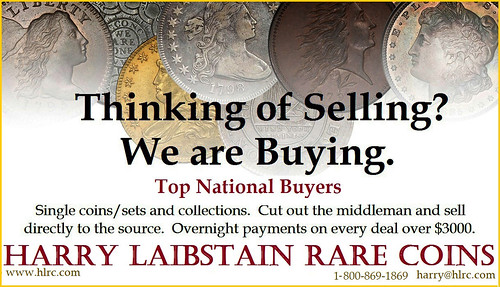
ANA MUSEUM MOUNTS MONEY OF EMPIRE EXHIBIT
The ANA Edward C. Rochette Money Museum has a new exhibit on British coinage. Here's the announcement. Every collector should put a visit to the ANA headquarters on their bucket list - the Museum, Library, ANA staff and Colorado Springs are all well worth a visit. -Editor
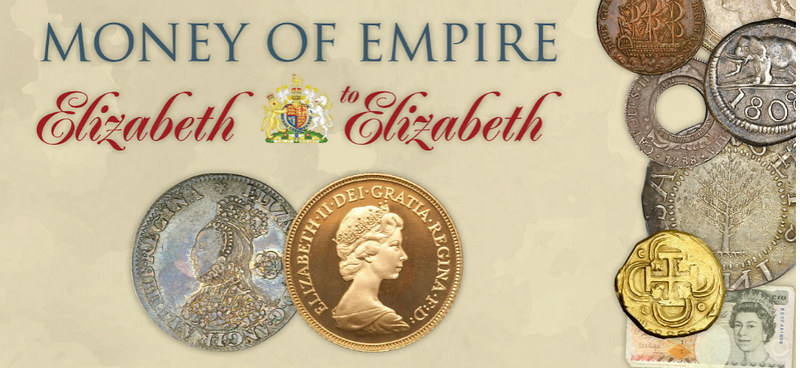
"Money of Empire: Elizabeth to Elizabeth"
The British Empire, more than any other, set the stage for the modern world in which we live. From small origins during the late 16th century, the British Empire expanded to become the largest empire in history and the most powerful global economic and military power for over a century. To celebrate the history of the British Empire, the Edward C. Rochette Money Museum, operated by the American Numismatic Association, is unveiling its newest exhibit, "Money of Empire: Elizabeth to Elizabeth," on March 7.
"The Money of Empire exhibit will take visitors on a numismatic tour of the British Empire and explore the history of the Kings and Queens of the UK from the time of Elizabeth I to Elizabeth II through their money and medals," said Douglas Mudd, museum curator. The new exhibit will be on display through April 2020.
Sixty-two modern nations were once part of the British Empire, most of which are now part of the Commonwealth of Nations. The Commonwealth consists of 53 member states united by language, history, culture and shared values. Sixteen of the countries recognize the British monarch as their head of state and continue to display Elizabeth II on their coinage - making her image the most common numismatic portrait worldwide.
Notable artifacts on display include:
• The Armada medal. The silver medal was issued in 1588 to celebrate the defeat of the Spanish Armada by the English Navy. Since the Armada was aimed mainly against Elizabeth, the head of the Anglican Church, its cause was viewed as an attack upon the Church itself and is clearly represented on the reverse.
• An Elizabeth I, gold 1/2 Pound, 1560-61. An early English machine-struck gold coin, the piece is a rare and beautiful example of Elizabethan coinage. The exhibit has a seldom-seen set of Elizabethan gold and silver coins on display.
• An Elizabeth I, silver 8 Real Portcullis money, 1600. This was the first English trade coin struck specifically for use in Asia. A complete denomination set is on display, a numismatic rarity.
• A Charles I, gold triple Unite, 1642, Oxford mint. This rare gold coin features Charles' wartime proclamation: Religio Protestantium, Leges Angliae, Libertas Parliamenti (Protestant Religion, English Laws, Liberty of Parliament)

Money Museum Background
The Money Museum includes an extensive and ever-growing collection of historical numismatic treasures. This one-of-a-kind facility showcases some of the most
valuable and significant numismatic items the public cannot see anywhere else. Rarities include the Harry W. Bass Jr. exhibit, one of the most complete U.S.
gold coin collections ever assembled, and two of the 15 known 1804 dollars valued together at $6 million.
The Money Museum is located at 818 N. Cascade Ave, adjacent to the campus of Colorado College and next door to the Colorado Springs Fine Arts Center. Museum hours of operation are Tuesday-Saturday, 10:30 am-5 pm. Admission is $8 ($6 for seniors, military and students). Kids 12 and under are free. For more information, call 719-632-2646 or visit www.money.org/money-museum.
For more information, see:
Money of Empire: Elizabeth to Elizabeth
(https://www.money.org/moneymuseum/money-of-the-empire)
NUMISMATIC LINGUISTICS
Mitch Sanders' February 2019 blog on the American Numismatic Association web site tackles the subject of numismatic linguistics. Here's an excerpt - see the complete piece online. -Editor

You certainly don't need to be a linguist to enjoy numismatics. But, after studying the many, varied uses of language on coins and currency, you just might become one
You can also see linguistic variety in the presentation of country names, which are not necessarily the same in all languages. Sometimes the translation is easy; "Brasil" is obviously Brazil, and you can probably guess that "République Française" is the country English-speakers call France.
But it's not always so clear. In German, Germany is "Deutschland." The country we knew as the U.S.S.R. abbreviated itself "C.C.C.P." And you might need to do some searching to figure out that "Confoederatio Helvetica" is the Latin name used by multilingual Switzerland, and that "Magyar Köztársaság" is Hungary in Hungarian. Oh, and coins without a country name? They're probably from Great Britain.
The familiar letters of the Latin alphabet are used in English and most European tongues, but other countries use different symbols. For example, the Greek and Russian alphabets are a mix of familiar and unfamiliar letters. Farther afield are Hebrew and Arabic, Korean and Japanese, and the character-based presentation of Chinese. Interestingly, in the global economy of the 20th and 21st centuries, one can find connections to English even in countries where it is not official or widely used: nearly all nations use the same Arabic numerals familiar on American money.
Latin is also commonly used for royal titles. Queen Elizabeth's designation as "By The Grace of God, Queen, and Defender Of The Faith" defies sensible abbreviation, but shortening "Dei Gratia Regina Fidei Defensor" to D∙G∙REG∙F∙D fits quite nicely on a coin. And sometimes Latin is used for a touch of gravitas, for example, with "FIDEI SVORVM REGNAT" (He reigns by the faith of his people) on a 1939 Canadian dollar.
In the "pun intended" category, wordplay is sometimes an interesting part of numismatic design. In the United States, the "Old Spanish Trail" commemorative half-dollar of 1935 honors Spanish explorer Cabeza de Vaca with an image that conveys the literal meaning of his name: the head (cabeza) of a cow (vaca).
To read the complete article, see:
NUMISMATIC LINGUISTICS
(https://www.money.org/numismatic-blog/numismatic-linguistics)

U.S. MINT DIRECTOR DAVID J. RYDER INTERVIEWED
Lou Golino published an excellent interview with Mint Director Ryder March 20, 2019 on Coin Week. Here's a short excerpt - be sure to see the complete article online. -Editor
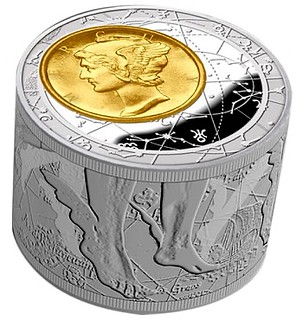 In less than a year, Mr. Ryder has already had a substantial impact on the U.S. Mint's operations and products. For example, he has initiated
partnerships with several foreign mints to develop products jointly with them and recently appointed Joseph Menna as the 13th Chief Engraver after that
position remained unfilled for almost a decade after the retirement of John Mercanti in 2010.
In less than a year, Mr. Ryder has already had a substantial impact on the U.S. Mint's operations and products. For example, he has initiated
partnerships with several foreign mints to develop products jointly with them and recently appointed Joseph Menna as the 13th Chief Engraver after that
position remained unfilled for almost a decade after the retirement of John Mercanti in 2010.
To explore his current initiatives and his ideas for revitalizing the Mint, I conducted a wide-ranging interview with him on March 15 on everything from different forms of Liberty to how to better market numismatic products, work with the Congress to help craft legislation that impacts the Mint and encourage more young people to enter the hobby and many others. During our discussion, he shared some important news that has not been previously reported.
One of the first questions was about the appointment of Joe Menna as Chief Engraver. -Editor
DR: One of the first things I did when I got here was to get the Chief Engraver position back into the Mint and engraving organization because I think it is important. I like Joseph's style and his enthusiasm for the job, and think he will bring that to the Philadelphia Mint and engraver shop. I encourage them to do a much better job. I encouraged him to be creative and along those lines encouraged the CCAC [Citizens Coinage Advisory Committee] to be more creative in their selection of designs.
I have been very vocal with our design staff to be more creative. I like the Artist Infusion Program to get more artists involved. I am a big proponent of changing the status quo as far as designs. And Treasury Secretary Steven Mnuchin is very involved in the process. I think with Joe on board and a different philosophy going forward with designs, I think it will go a long way. There are still things out of my control in the context of how designs are selected. But going forward I plan on being a proponent to help legislators better interpret the legislation and be more creative as far as designs. And to have language that gives designers more freedom, so I am a big proponent of changing the status quo.
To read the complete article, see:
Challenging the Status Quo: An
Interview With U.S. Mint Director David J. Ryder
(https://coinweek.com/us-mint-news/challenging-the-status-quo-an-interview-with-u-s-mint-director-david-j-ryder/)

KAGIN'S MARCH 2019 ANA AUCTION PREVIEW
Here is an overview of highlights from the upcoming Kagin's sale at the Pittsburgh American Numismatic Association National Money Show, gathered from the firm's press releases in recent weeks. -Editor
1877 $50 Half Union Pattern

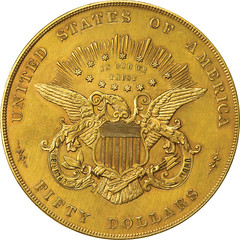
Kagin's Auctions, the Official Auctioneer for the American Numismatic Association National Money Show to be held March 28-29th at the David Lawrence Convention Center in Pittsburgh, Pa. will feature the very Rare and impressive 1877 $50 Half Union Pattern J-1547.
Among the most celebrated of U.S. coinage rarities-even though properly a pattern-the gold $50 Half Union (a $100 Union coin was also contemplated but never struck) consisted of a solitary gold pattern with coiner William Barber's Large Head design. A single smaller head design is also known with BOTH gold specimens now permanently in the Smithsonian Institution.
These pieces were never struck for circulation and it wasn't until the 1915-S Panama-Pacific gold $50 coins that the denomination actually saw fruition.
Of the ten confirmed examples in copper, four are in museums and several are gilt. The Kagin specimen being offered unreserved is PCGS certified gilt Proof-63RB CAC and is considered the second finest known (one is Proof-65).
Clark, Gruber & Co Mountain Twenty

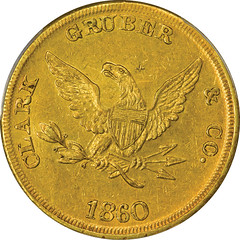
A newly certified $20 1860 gold piece from the pioneer private coiner, Clark, Gruber & Co. of Denver, Colorado is being offered unreserved by Kagin's Auction in the upcoming official American Numismatic Association National Money Show Auction on March 28-29th at the David Lawrence Convention Center in Pittsburgh, Pennsylvania.
The new-to-the-census "Territorial" gold coin is graded PCGS Genuine-Graffiti-AU Details and sports the most popular and iconic coin design of the Colorado Gold Rush of 1859-1862. It has been dubbed the "Mountain Twenty" because of its attempted rendering of the famous "Pike's Peak" mountain on the coin's obverse.
The original engraving on the obverse was actually an unfortunate mistake. At the start of the Colorado Gold Rush in March, 1859, banker Clark, Gruber & Company were heavy buyers of gold dust. They would ship the gold to the U.S. Mint in Philadelphia to be melted and coined into money. This process was quite costly due to shipping costs and insurance and often took as long as three months. Eventually senior partner, Milton Clark ordered coining equipment from Philadelphia and New York and established their own private mint in Denver in August, 1860.
Clark had hired a Philadelphia jeweler to create dies with a design for the famous Colorado mountain, Pike's Peak. Unfortunately, the jeweler had never been west of the Mississippi River and had no idea what the mountain looked like. The rendering he engraved bore no resemblance to the actual peak and Clark, Gruber & Co. was severely criticized and embarrassed. The next year they replaced those dies with ones of the familiar U.S. Liberty Head. But the popularity of the "Mountain $10s and $20s" has long endured.
This specimen is new to the census and has just been certified. Fewer than two dozen pieces are known including several impounded in museums.
Anderson Collection of Treasury Notes of the War of 1812
Believed to be the Finest collection of the first circulating currency of the United States, the Joel Anderson collection of the Treasury Notes of the War of
1812 will give collectors a very rare opportunity to acquire remainder, specimen and circulating notes from one of the most important and challenging series of
U.S. banknotes.
This Treasury Note offering including ancillary material will be offered by Kagin's Auctions as part of the annual American Numismatic Association National Money Show Auction to be held in Pittsburgh, Pennsylvania March 29th 2019.

The War of 1812 triggered the United States' first severe financial crisis since the American Revolution. Often called our nation's, "Second War of Independence", the conflict erupted after an extended disagreement with Great Britain over trade tariffs and Britain's continued capturing and impressing of U.S. citizens for their maritime service and for fighting against France. As the war dragged on, it became clear that the usual import tax revenues and loans would not be enough to pay for the conflict.
Proposals for issuing a circulating paper currency were bitterly opposed by many Founding Fathers including Secretary of State Thomas Jefferson, and eventual President James Madison, as well as several Congressmen who recalled the hyperinflationary effects from the earlier unfettered proliferation of Colonial Currency. However, currency proponents including Alexander Hamilton and the strong financial and banking interests eventually prevailed when the government finally resorted to issuing Treasury notes that were, "payable to bearer, transferable by delivery and receivable in all payments for public lands and taxes." The result was the passage of five acts authorizing interest-bearing notes with the last act of February 24, 1815 including "small" Treasury notes of denominations of $3, $5, $10, $20 and $50. These small notes did not bear interest but when fully signed, circulated for money. This latter issue although not given "legal tender" status, nevertheless clearly was accepted as such.

The featured item in the Kagin offering is the unique $10 TN-14b (now designated as TN-14c in the just published Treasury Notes of the War of 1812 by Donald H. Kagin, Ph.D.). This note is doubly signed by two clerks and countersigned by James Dickson presumably acting on behalf of the Register of the Treasury. It is the only such note known of this denomination although a $3 fully signed note exists and possibly another fully signed $10 bill countersigned by John Calhoun. According to the cataloger, this note, (which was depicted in a line drawing in the 1978 reprint of 1885 book, United States Notes by John Jay Knox) , recently surfaced at the 2015 FUN show and this is the first time that it has been offered publicly. It is considered to be, the first Circulating Bank Note of the U. S. Government and is estimated by the auction house at $150,000-$250,000.
Encased Postage Stamps
38 lots of encased postage stamps are up for sale in Kagin's Auctions American Numismatic Association's National Money Show on March 29, 2019 at the David
Lawrence Convention Center in Pittsburgh, Pennsylvania. Specimens include some of the finest known pieces from over 25 different merchants. Highlighting the
collection is an Extremely Fine example of the rare 5c Sands Ale.
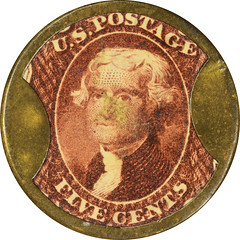

Sands Ale Five Cents Encased Postage Stamp
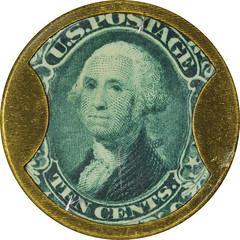
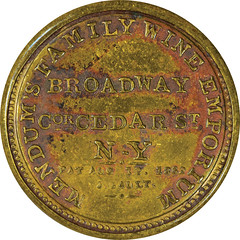
Mendum's 10 Cents Encased Postage Stamp
The Sand's Ale issue is very rare and one of the keys to the series. I had a Sand's in my U,S. Civil War collection. It was one of my favorite pieces and a highlight of the sale in 2006. Mendum's is a tough one, too. -Editor
Chambliss Collections of World Currency
"One of the finest and most complete collections of Israeli banknotes and a dozen Palestine notes from the Carlson Chambliss collection will be offered
unreserved in our official ANA National Money Show in Pittsburgh, Pa. on March 29, 2019," announced Don Kagin, president of Kagin's Auctions.

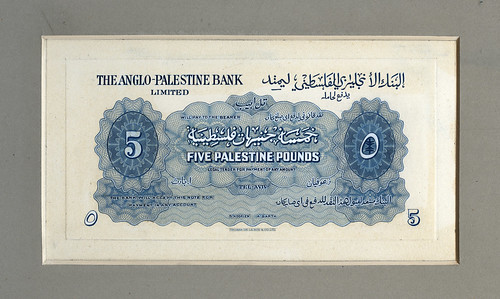
Highlights include the 9/30/1929 5L and10L Palestine Currency Board notes graded PMG 30 and PMG 40 respectively, and a possibly unique set of OBVERSE and REVERSE proofs of a $5 Anglo-Palestine Bank Limited note (1948) Pick UNLISTED.
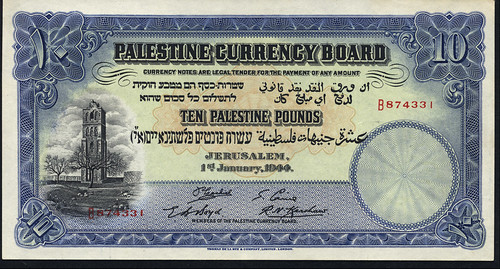
WE INVITE THE INTERNATIONAL HOBBY TO PERUSE THE Other special notes including a complete gem set of the unissued Emergency Notes of 1948 printed by the Anglo-Palestine Bank. They will be provisionally represented individually and then SOLD AS single lots. 1948 fractional notes as well as the scarce Tel Aviv Tax coupons and fractional notes of 1952 will be offered. Many are thought to be the finest known. Specimen notes as well as modern notes will also be available.
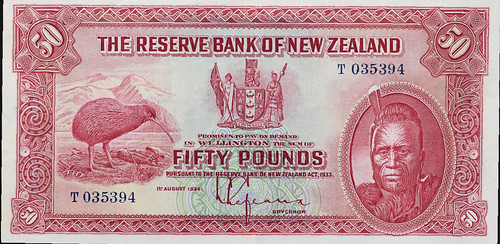
Additionally, The Chambliss New Zealand currency collection features the single Finest known PMG XF-45 EPQ 50 Pound "Kiwi" 1/8/1934 Reserve Bank note estimated at $30,000-$50,000.
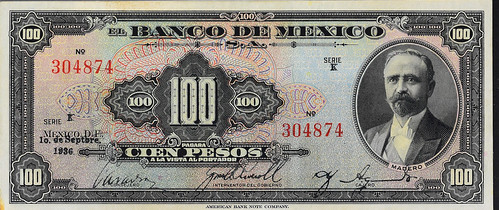
The Mexican Bank Note Collection is quite comprehensive and other country banknotes include Bermuda, Germany, France, Russia, South Africa, Switzerland and others.
For more information, see:
https://www.kagins.com/

CNG OFFERS COINS OF THE VALERIANIC DYNASTY
CNG is offering a comprehensive collection of the coins of the Valerianic Dynasty. -Editor
(AD 253-268) and Contemporary Issues to be sold by CNG
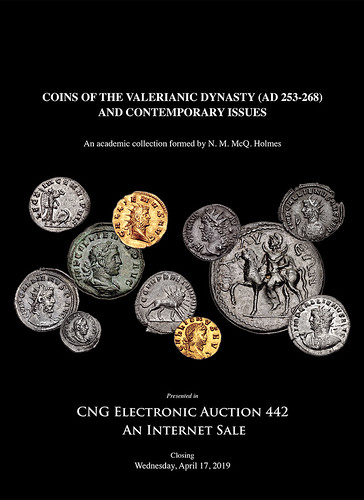 PA-Classical Numismatic Group, LLC, of Lancaster, Pennsylvania and London, England, is pleased to announce the sale of the N. M. McQ. Holmes
Collection of Coins of the Valerianic Dynasty (AD 253-268) and Contemporary Issues. The Holmes collection will be offered in its entirety as CNG Electronic
Auction 442. Consisting of 874 lots, CNG E-Auction 442 will open on Wednesday, 3 April 2019, and close on Wednesday, 17 April 2019, beginning at 10AM. A
limited edition, printed catalog of the collection will also be available.
PA-Classical Numismatic Group, LLC, of Lancaster, Pennsylvania and London, England, is pleased to announce the sale of the N. M. McQ. Holmes
Collection of Coins of the Valerianic Dynasty (AD 253-268) and Contemporary Issues. The Holmes collection will be offered in its entirety as CNG Electronic
Auction 442. Consisting of 874 lots, CNG E-Auction 442 will open on Wednesday, 3 April 2019, and close on Wednesday, 17 April 2019, beginning at 10AM. A
limited edition, printed catalog of the collection will also be available.
A life-long academic numismatist, Holmes was originally attracted to the coinage of emperors such as Gallienus and Claudius II since the coins "could be obtained without large financial outlay." As he explains in the introduction to the collection: "Common types could be purchased for just a pound or two each. Once in paid employment I was able to expand the range of my collecting to some extent, but I very soon discovered that many of my colleagues in the archaeology and museum professions were deeply opposed to the idea of those employed in this type of work forming private collections at all - an attitude which unfortunately still persists in some quarters today. I disagree with this fundamentally, as I believe that those who are fortunate enough to be able to accumulate numismatic knowledge in the course of their employment are best placed to carry out research on, and publish discussion of, interesting items that appear on the open market. I do, however, accept that it is at the very least unwise to collect in the same field as an institution where one is employed, as aspersions can be cast, however unjustly, and these may harm one's reputation. It was fortunate for me, therefore, that neither of the institutions which employed me throughout my career had any interest in acquiring mid third-century Roman coins."
"Consequently, I felt able, with a clear conscience, to enlarge my collection relating to this period of history, and for a time my aim, like that of many other collectors, was simply to acquire as many different types from within my chosen date range as possible, which I narrowed down to AD 253-268. It rapidly became clear that the coinage of Gallienus, in particular, was amongst the most innovative of all Roman imperial issues. As time passed, and particularly when I obtained employment as an academic numismatist, I decided that my acquisition policy should be geared to more than just accumulation, but should be formulated in order to provide some sort of service to numismatists, both professional and amateur. The result is this collection now being published and offered for sale," Holmes continued.
The Holmes collection consists of coins that "range from the unique to the very common," with such highlights as the largest offering ever of the legionary antoniniani of Gallienus, with over 90 different varieties. For both the online and printed catalog, Holmes prepared an introductory paper on the iconography of the coinage of the Valerianic dynasty, which includes appending notes to many of the catalogue entries for individual items. Holmes stated, "I hope that others may find these of interest and of benefit. Coins in this collection range from the unique to the very common, but those in the latter category, which I have retained to the end, are there because they serve to illustrate aspects of the iconography study."
The limited edition printed catalog, with only 150 copies available, will be available after April 3rd. To order a catalog, please visit www.cngcoins.com. The catalog is $35 to North American addresses, and $65 to the rest of the world. Payment may be made by U.S. $ check or Visa/MasterCard.
For further details and any additional information, please contact CNG, LLC at:
Classical Numismatic Group, LLC
P.O. Box 479
Lancaster, PA 17608-0479
Telephone: (717) 390-9194
Fax: (717) 390-9978
Email: cng@cngcoins.com
For more information, see:
https://www.cngcoins.com/
At my request Kerry Wetterstrom of CNG kindly provided these additional images of coins from the sale. Thanks. -Editor
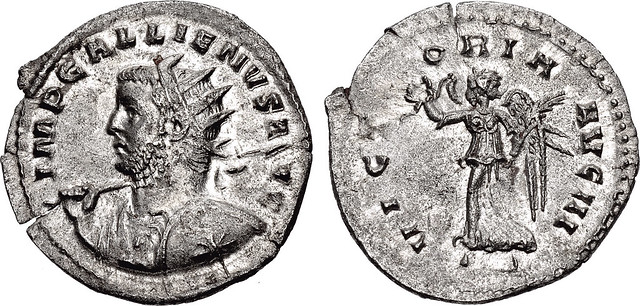
Lot 155 Gallienus. AD 253-268. Antoninianus (22mm, 2.31 g, 4h). Rome mint. 6th issue, AD 260-261. IMP GALLIENVS AVG, radiate and cuirassed bust left, holding spear and shield, viewed from front; star on shield / VICTORIA AVG III, Victory walking left, holding wreath and palm. MIR 36, 387z; RIC V (sole reign) 304 var. (bust type, and no mint-mark); Cunetio -; Normanby -; Chalfont -. EF, lustrous, thin flan crack. Extremely rare, only one specimen noted by MIR (in the KHM [Vienna]).
Ex Künker 143 (6 October 2008), lot 681.

Lot 409 Gallienus. AD 253-268. Antoninianus (22mm, 3.01 g, 12h). Mediolanum (Milan) mint. Issue 2(2), AD 260-1. GALLIENVS AVG, radiate and cuirassed bust right / LEG XIII GEM VI P VI F, Victory standing right, holding wreath; eagle at her feet. MIR 36, -; RIC V -. Near VF, some silver content. Well struck reverse.
Ex Jacquier 43 (15 September 2017), lot 247.
This coin has the badge of Legio V Macedonica combined with the name of Legio XIII Gemina, which should be accompanied by Victory and lion.

NUMISMATIC AUCTIONS LLC SALE 63
Steve Davis of Numismatic Auctions LLC forwarded this press release with highlights of his firm's upcoming sale 63. Thanks. -Editor
Monday, April 29, 2019
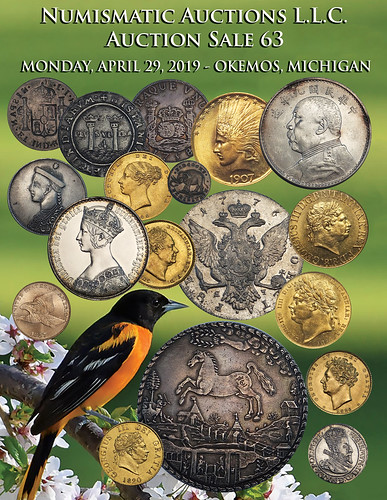 Numismatic Auctions L.L.C. proudly presents our 63rd public and absentee bid catalog sale which will take place Monday, April 29, 2019 on the heels
of the Central States convention. This auction contains several terrific buying opportunities for the collector community such as a landmark time capsule of
British Empire Gold, an interesting selection of better U.S. and Canadian Coins and collector grade lots plus Ancients, Medieval and a fascinating montage of
World Coins, Tokens, Medals and Paper Money. Within the World Crown & Minors section are several lifelong holdings that were meticulously assembled by
date, denomination and type with little or no duplication, affording the buyer an opportunity to jump into a nation or region of interest with both feet
acquire a wonderful core collection to build upon, compliment or complete their current assets.
Numismatic Auctions L.L.C. proudly presents our 63rd public and absentee bid catalog sale which will take place Monday, April 29, 2019 on the heels
of the Central States convention. This auction contains several terrific buying opportunities for the collector community such as a landmark time capsule of
British Empire Gold, an interesting selection of better U.S. and Canadian Coins and collector grade lots plus Ancients, Medieval and a fascinating montage of
World Coins, Tokens, Medals and Paper Money. Within the World Crown & Minors section are several lifelong holdings that were meticulously assembled by
date, denomination and type with little or no duplication, affording the buyer an opportunity to jump into a nation or region of interest with both feet
acquire a wonderful core collection to build upon, compliment or complete their current assets.
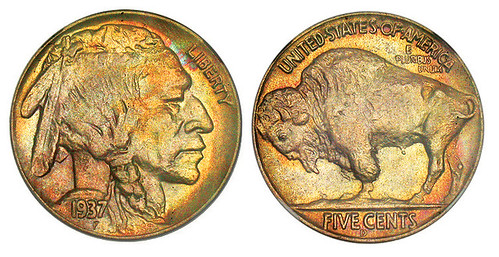
Lot 52: Rainbow toned Three Legged Buffalo
Among the many highlights this sale are an interesting run of U.S. Coins, type and series coins, short sets and more from Colonials & Half Cents to Dollars and more including some fabulous Key Dates such as an amazing Gem 1857 die clashed Flying Eagle; 1914-D and 1955 Double Die Lincoln Cents, a Rainbow toned Three Legged Buffalo in Choice Mint State followed by some high grade and colorful type and Proofs, a run of nice collector grade Capped Bust Halves and a fantastic 1836 Reeded Edge Half Dollar, eclipsed by a range of Dollars including a Gem Proof 1892 Morgan as well as an incredible quartet of Pan-Pac Gold from a discovery in the original envelope, followed by a neat ensemble of splashers, errors, Hawaiian material, paper and beyond.

Lot 176: Pan-Pac Gold with original envelope
The Canadian segment provides an interesting collector run of Large Cents to Silver Dollars and more including a Dollar set featuring the 1948 rarity, rare Canadian Sovereigns in numbers are contained in the World Gold section. The historic Ancient ensemble encompasses an enigmatic group with some better grade Greek, Roman and Byzantine coinage with a Gold presence, eclipsed by a unique specialized run of collector grade Medieval Coinage.

Lot 594
The anchor feature of the sale follows with a fantastic collection of British Empire Gold Sovereigns and Half Sovereigns which blankets the giant World Gold presentation. This group is highlighted by Aussie, Canadian & South African collector dates, rarities and Proofs along with a formidable mainline British collection being the dominant force, nearing completion by date with such rarities as Condition Census 1818 & 1823 Sovereigns, plus rare dates and grades defined by such enigmas as the 1828, 1841 & famous 1859 Ansell variety, many in early slabs plus larger denominations of 2 and 5 Pound examples, modern multi-coin Gold Proof Sets and beyond. The marvelous Commonwealth Gold listing is surrounded by a highly diverse group of additional Gold coins from a bevy of other nations, our conservative estimates will likely be left in the dust behind the recent gains in the metals market.
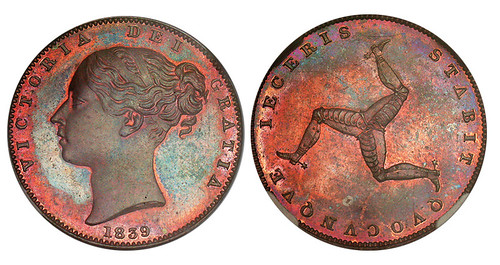
Lot 1349
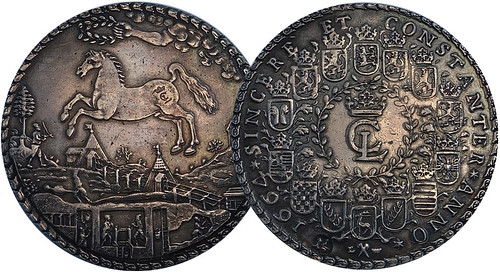
Lot 1069
The World Crowns and Minors segment of the sale is an impressive presentation, illuminated by the holdings of three multi-decade collections of foreign coins which have remarkably comprehensive type and date offerings in a bounty of nations A to Z. Just a quick overview enumerates nations of Africa, Asia and the Middle East, British, British Commonwealth, South American, Chinese, Early German States, Austro-Hungarian and an infinite number of other regions. Another exciting twist is a huge group of Hundreds of Mexican and Latin American issues up to Cob & Milled 8 Reales along with rare minors and bulk lots, Russian, Nordic, Scandinavian and European material along with other World coinage in singles, sets, date/type runs and small group lots. The catalog contains page after page, with our largest coin count offering to date, detailing a vast strata of international coinage with intriguing country specific lots throughout.
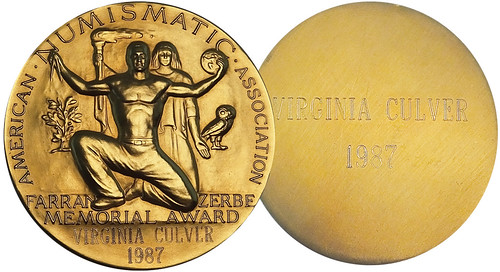
Lot 255: Farran Zerbe Award Medal
As usual we bring a monumental army of terrific miscellaneous lots under the auction gavel to round out the sale alongside singles, small groups & collections of Conder Tokens, Metal Notgeld and Swiss Shooting Medals, all listed intact with reference books finalized by a back of the book grouping of interesting paper money plus rare framed Art & Historical Colonial Documents. Stay tuned for Sale 64, which is already in the works & shaping up nicely!
The catalog can be viewed or downloaded digitally at www.numismaticauctionsllc.com and published copies can be requested at Numismatic Auctions L.L.C., P.O. Box 22026, Lansing, MI 48909, by phone at 517-394-4443 or by Email: numauctionsllc@aol.com - absentee bids for the sale must be received on or before Friday April 26, 2019 at 5:00 PM E.S.T.
For more information, see:
https://numismaticauctionsllc.com/
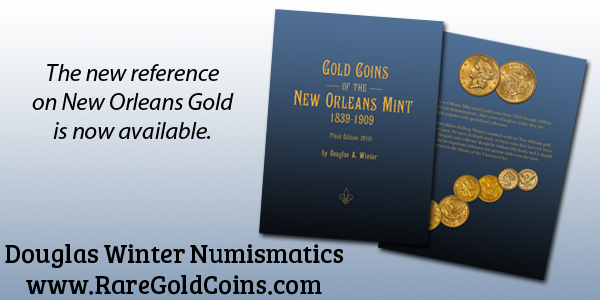
NUMISMATIC NUGGETS: MARCH 24, 2019
Here's a selection of interesting or unusual items I came across in the marketplace this week. Tell us what you think of some of these. -Editor
G. Loomis counterstamp on 1784 French Ecu
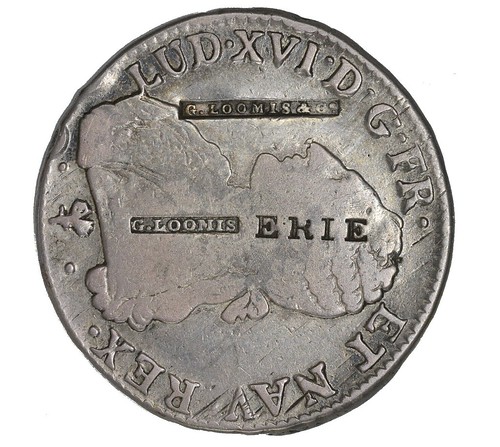
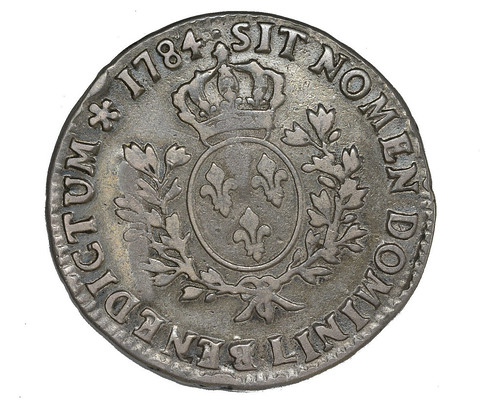
"G. LOOMIS & Co / G. LOOMIS / ERIE"
1784-L French Ecu
The two company name marks are in raised letters.
Brunk L-487.
Ex. Tony Terranova collection.
Born in 1795, Guy Loomis worked as a silversmith in Stockbridge, Massachusetts. In the October 31, 1816 edition of the Berkshire Star, Loomis advertised that he had "taken the stand recently occupied by David Bert, watchmaker and jeweler, nearly opposite the meetinghouse in Sheffield, where he keeps constantly for sale a handsome assortment of goods in his line, among which are English and French watches, gold and silver cornelian set watch seals and keys, silver teaspoons, candlesticks, thimbles, knives and forks, ear & finger rings, etc." In 1837, Loomis moved to Erie and by 1853 was listed there as a jeweler at 4 Brown's Block. There he advertised "clocks, watches, jewelry, etc., also manufacturer of silver spoons." His obituary was printed in an 1874 edition of the Erie Observer, noting that he passed away in Windsor, Connecticut, and that he was a captain and in his 80th year.
Nice piece. Erie is north of Pittsburgh, my hometown. Counterstamps on foreign coins are superb evidence of the circulation of foreign coins in the U.S. Without the mark, it would just be an ordinary 1784-L French Ecu. From the eBay auctions of reader Bob Merchant. -Editor
To read the complete lot description, see:
Rare Erie PA Counterstamp 1784 French
Dollar "G. LOOMIS & Co / G. LOOMIS / ERIE"
(https://www.ebay.com/itm/Rare-Erie-PA-Counterstamp-1784-French-Dollar-G-LOOMIS-Co-G-LOOMIS-ERIE/132991225315)
1904 World's Fair Brothel Token
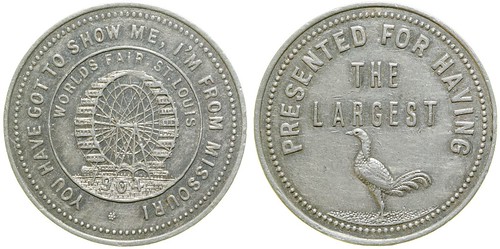
34 mm, round aluminum brothel token. Obv: YOU HAVE GOT TO SHOW ME. I'M FROM MISSOURI / surrounding an image of the famous Ferris Wheel. Rev: PRESENTED FOR HAVING / THE LARGEST / image of a young rooster. Historically, the red-light district lined the street across from the entrance to the fair grounds. City: St Louis State: Missouri Date: 1904
From the Holabird 2019 WESTS Auction held this week. The piece hammered for $500. -Editor
To read the complete lot description, see:
World's Fair Brothel Token (101995)
(https://holabirdamericana.liveauctiongroup.com/World-s-Fair-Brothel-Token-101995_i32828563)
Inspiration: Frank Eliscu's Multi-Part Pegasus Medal
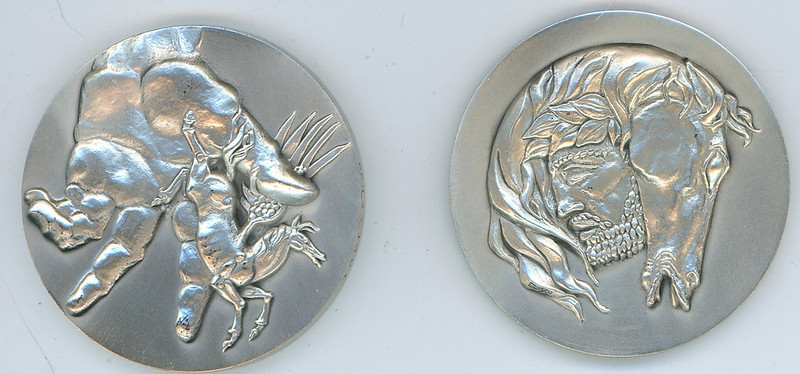
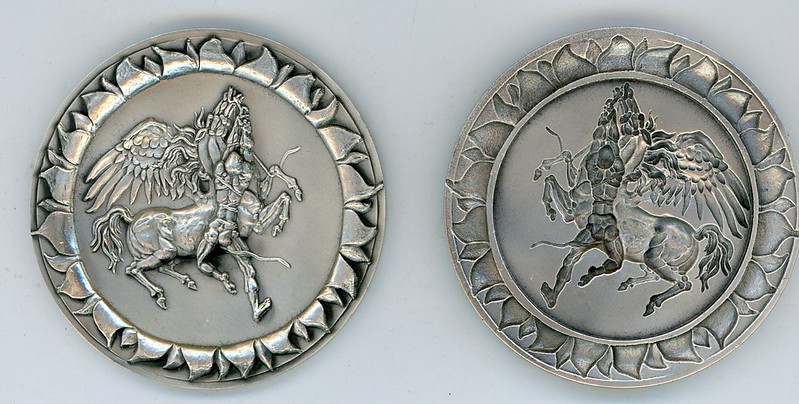
"INSPIRATION" - MULTI-PART MEDAL, (1974). 56mm. .999 silver. (7.4 oz.) Frank Eliscu, Sc. (MACO). Unc. Original case & pamphlet. Edge numbered BB92/1000. A four surface medallion; obverse, reverse and two internal surfaces which can be viewed only when the medal is parted. The obvers shows Pegasus being released from the hand of God. The reverse, struck in bronze, shows the head of man and Pegasus. The two interface surfaces show man the artist harnessing Pegasus by the use of tools. The two surfaces, one intaglio, lock together and form a unified medal.
This medal was struck in three editions. (1) The medal struck in all bronze was issued at $15.00 and had an edition limit of 2500.00; (2) The medal struck half in silver and half in bronze was issued at $60.00 had a limit of 2,000 and (3) the medal struck in all silver was sold for $120.00 and was limited to 1,000. No firm mintage figures are available, but we would be quite surprised if any of the versions were struck in quantities any where near their edition limits $225.00
Interesting medal - I hadn't seen this one before. From Joe Levine's Token and Medal Mini fixed Price List #152. Joe can be reached at JLevine968@aol.com. -Editor
THE BOOK BAZARRE
JERSEY GROUVILLE HOARD WAS TWO COLLECTIONS
Found via The Explorator newsletter is this article with the latest news on the massive Grouville hoard of Celtic coins. -Editor

THE largest hoard of Celtic coins and jewellery ever found, which was unearthed in a Grouville field in 2012, is revealing yet more secrets about life in Jersey and northern France 2,000 years ago.
Meticulous work overseen by Jersey Heritage to conserve and study the so-called Le Câtillon II hoard - which includes 70,000 gold and silver coins and 11 gold torques - has been going on for seven years.
The latest findings follow the use of laser-mapping and engineering data-analysis techniques.
They show that it is actually two collections of coins, possibly from different tribes or rich dynasties, which were hidden together as Roman legions advanced through what is now France in the first century BC. It is possible that one of these groups was from near Dinan, in Brittany, and the other from Normandy.
During the three years it took to disassemble the hoard, which came out of the ground in one large piece after being found by metal detectorists Reg Mead and Richard Miles, the position of every coin and other items was recorded using the laser-mapping techniques.
Mr Miles explained that the study of the data had revealed some surprising results.
'Research suggests that the hoard is not, as previously thought, a single mass of material, but a complex arrangement of items divided into two separate and distinct areas of coin composition, origin and age,' he said.
Dr Philip de Jersey, archaeologist for the States of Guernsey and a world-renowned expert on Celtic coins, said: 'This research into the hoard composition is fascinating. This is the first time we have been able to examine a Celtic hoard in such detail. No other hoard has been disassembled with such precision and care, permitting an in-depth understanding of both the composition and the burial process.
To read the complete article, see:
Coin hoard reveals its latest secret - it
was two collections (https://jerseyeveningpost.com/news/2019/03/24/coin-hoard-reveals-its-latest-secret--it-was-two-collections/)
To read earlier E-Sylum articles, see:
WORK CONTINUES ON CELTIC COIN HOARD FOUND IN JERSEY
(https://www.coinbooks.org/esylum_v16n25a24.html)
JERSEY GROUVILLE HOARD BEING DISMANTLED (https://www.coinbooks.org/esylum_v17n35a32.html)
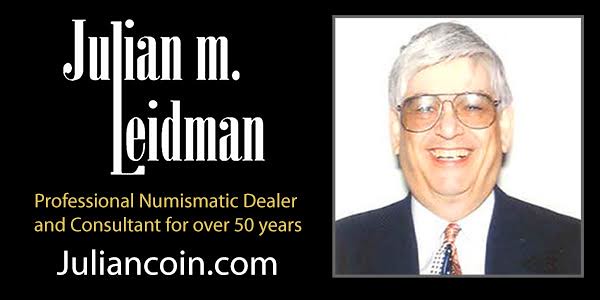
QUERY: DRAKE'S PLANTATION BITTERS INFO SOUGHT
Dave Bowers submitted this call for assistance on his latest book project on encased postage issuer Drake's Plantation Bitters. -Editor
I am in the final stages of a book that will be published by TAMS. From E-Sylum readers I would appreciate information for two challenges:
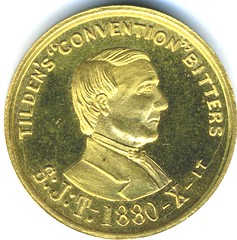
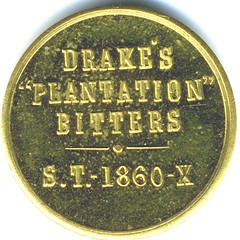
Are there any other TOKENS (not encased postage stamps) other than this one?
 Do any readers have the first three issues, 1869 to 1871, of Morning, Noon and Night, the Drake's almanac? Cover of 4th issue attached. If so I would
like to buy or to pay to have high-resolution copies of certain features). Please contact me at qdbarchive@metrocast.net.
Do any readers have the first three issues, 1869 to 1871, of Morning, Noon and Night, the Drake's almanac? Cover of 4th issue attached. If so I would
like to buy or to pay to have high-resolution copies of certain features). Please contact me at qdbarchive@metrocast.net.
Can anyone help? I've never seen either of these items before. -Editor
QUERY: 1771 PUGACHEV ROUBLE
Web site visitor Lance Schweiter asked,
I have a 1771 Pugachev Sestroretsk rouble - can you tell me if it is genuine?

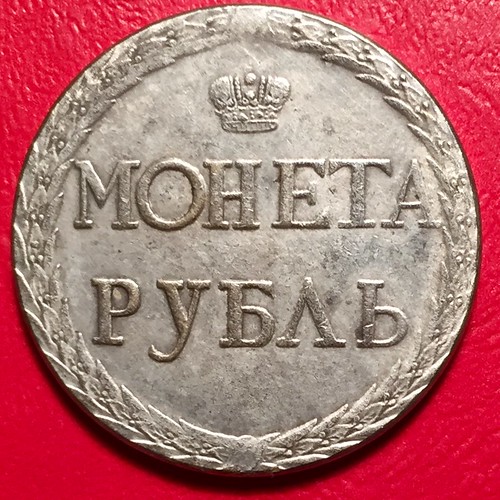
I passed this along to my friends Steve Bishop and Eric Schena, both serious collectors of Russian coinage. -Editor
Steve writes:
It appears to be a cast copy. The real thing would be much sharper (see picture). Also, they are really rare, so the odds of it being genuine is essentially zero. You can get a much nicer copy for $50 here: https://www.soviet-power.com/detail.php?pid=1276 .
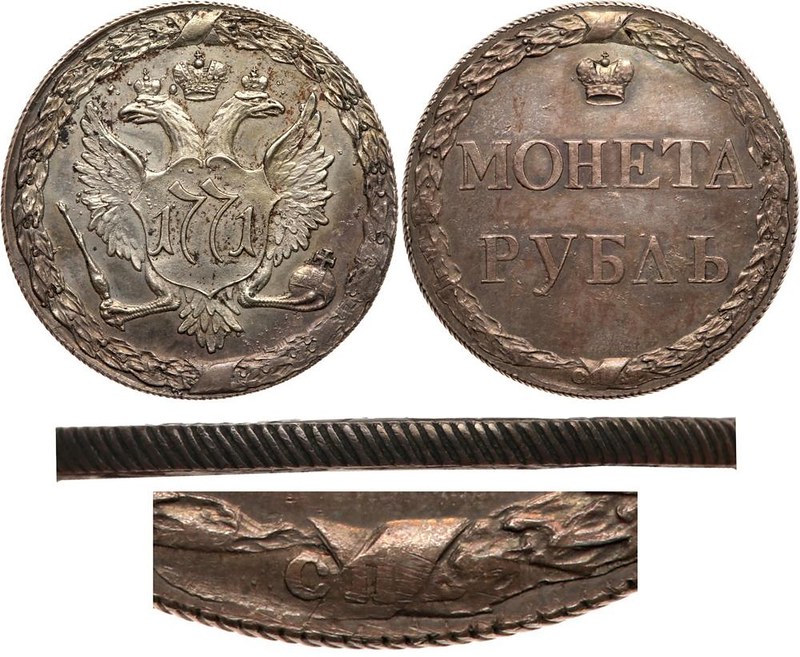
A genuine Pugachev Rouble
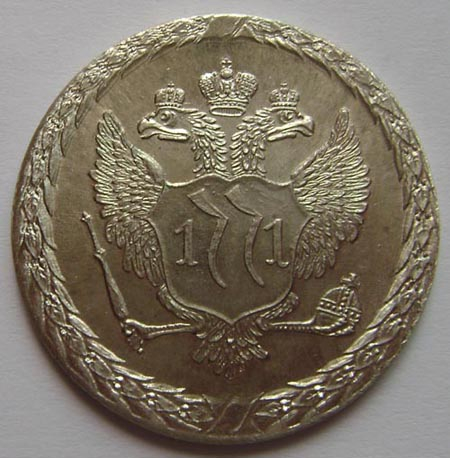
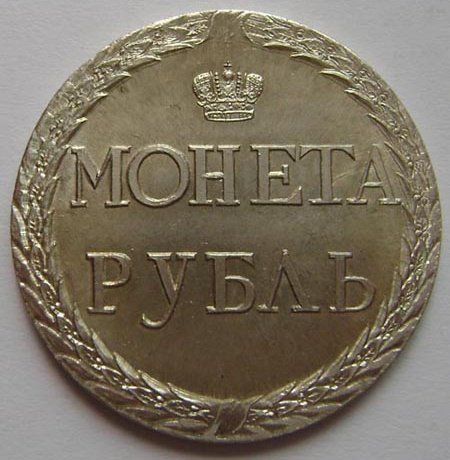
Repro Pugachev Rouble
Lance responded:
The picture you sent is a completely different coin. It has a C mintmark and my coin is made of silver and counterfeits of this date are rare. Unless it is a really modern copy. The counterfeits for sale look copper and are in pristine condition. Here is a genuine one according to the site and it looks exactly like mine. The coin does not stick to magnet. It came from Russia so it is not a modern fake.

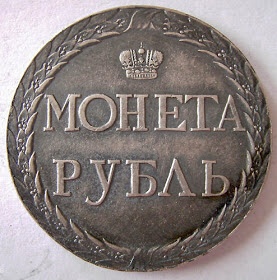
From: https://www.worldbanknotescoins.com/2013/08/russian-coins-ruble-sestroretsk-ruble.html
I replied,"I would say your coin does NOT look ENOUGH like this to be genuine. The surface is bumpy and that is how cast copies look. Since it doesn't stick to a magnet that rules out iron or steel but doesn't mean it's silver. Yours has a silvery color, but it doesn't look silver to me either. It looks like white metal or lead." -Editor
Steve writes:
The picture I sent is a rare variant which was in a Goldberg auction. I meant it to show how a struck coin would look as compared to a cast.
Russia is the primary source for fakes of old Russian coins. There are dozens of listings on eBay by Russian sellers of modern fakes. I've bought some to have a representation of such classic rarities as the Sestroetsk rouble, and yes, the Pugachev rouble.
Eric Schena writes:
I concur with Steve and you: that does not look like a genuine example. The one Steve illustrated is much sharper, plus it was overstruck on an earlier ruble (the C is a portion of the St. Petersburg Mint mark of the undertype). Most if not all genuine examples are found overstruck on silver rubles. The dies on the original "Pugachev ruble" were also used on the massive hockey puck sized Sestroretsk rubles and will be die linked with those, as well.
These coins have been copied extensively for generations in all metals, including silver. Because the originals are so exceptionally rare and most known examples well documented, it is equally unlikely that this one is genuine. It would be the Russian numismatic equivalent of finding an 1804 dollar.
Steve writes:
There is one unique example struck over a copper 5 kopeck piece in the Hermitage. I have a copy of that one, struck over a genuine 5 kopeck. I also have a copy of the unique 1770 Sestrotsk rouble, also in the Hermitage, both acquired from Russian sellers on eBay.
Thanks, everyone. Steve, Eric and I have gone as far as we can based on the images. For a definitive opinion, the coin should be submitted to a certification service such as NGC. See https://www.ngccoin.com/ . -Editor
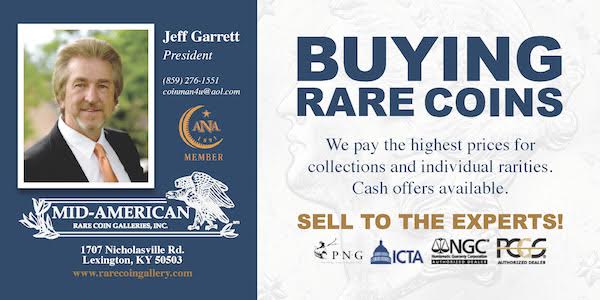
QUERY: U.S. COINAGE MINTAGE FIGURES SOUGHT
Dave Bowers forwarded this inquiry from Jerry Diekmann. -Editor
Hello, Mr. Bowers:
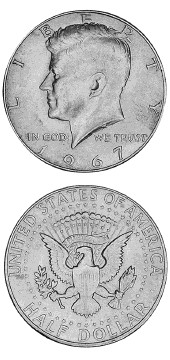 I have been a coin collector for over 50 years now and have always enjoyed reading your articles and have purchased several of your books. I do have
a question that I have never seen addressed, much less answered, in the coin collecting community, and that relates to the mintages of coins with no mint marks
that occurred from 1965 into the mid-1980s.
I have been a coin collector for over 50 years now and have always enjoyed reading your articles and have purchased several of your books. I do have
a question that I have never seen addressed, much less answered, in the coin collecting community, and that relates to the mintages of coins with no mint marks
that occurred from 1965 into the mid-1980s.
All the coins from 1965 to 1967 were minted without mint marks but I am wondering if the Mint ever reported the individual mintages among Philadelphia, Denver, and San Francisco, and also if they ever reported the actual number of coins minted during each of those years. I believe 1964 coins were minted into 1966, and 1965 dated coins from very late in 1965 into the middle of 1966. For the cents, from 1975 through I think 1986, they were minted at all four mints, but those minted in San Francisco and West Point were struck without mint marks, so they are indistinguishable from the Philadelphia cents. Did the Mint keep records on the numbers of cents struck at West Point and San Francisco?
And the 1982 cents represent the biggest confusion of all, as there were seven different varieties that year, large date and small date, and copper vs. zinc plated coins. Were individual mintage records ever kept for these coins?
Finally, were any records kept for the 1960 small date and large date coins for Philadelphia and Denver? And are there any accurate records for the proof silver and uncirculated San Francisco bicentennial coins? I have never seen any breakdowns of the mintages in the Red Book or any other books, including the ones you have authored. If there are no accurate numbers available, are there at least any reasonable estimates of these unknown mintages?
I would appreciate any information you could share with me. Thank you.
Great questions! Dave had to decline to research this due to constraints on his time, but recommended The E-Sylum knowing how many smart, well-read numismatists we have in our number. So... can anyone help?
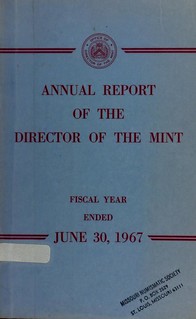 I'm not aware of any breakdown of the 1982 cent mintage figures. If there is a breakdown by mint of the 1965-1967 coinage then is would likely be
in the reports of the Mint Director for those years. The Redbook and other pricing guides would have had little reason to include those numbers since
the coins themselves would be indistinguishable and valued equally in the marketplace.
I'm not aware of any breakdown of the 1982 cent mintage figures. If there is a breakdown by mint of the 1965-1967 coinage then is would likely be
in the reports of the Mint Director for those years. The Redbook and other pricing guides would have had little reason to include those numbers since
the coins themselves would be indistinguishable and valued equally in the marketplace.
Like the 1982 cents, the small and large date 1960 cents were varieties and I doubt any records were kept.
The largest and most accessible collection of U.S. Mint Director reports is on the Newman Numismatic Portal. -Editor
To read the U.S. Mint Reports on the Newman Portal, see:
U.S. Mint Reports (https://nnp.wustl.edu/library/publisherdetail/51)

NEW STEPHEN HAWKING 50-PENCE COIN
I've been wanting to run something about the cool new Stephen Hawking coin; here's an excerpt from a great Coin Update article by Michael Alexander. -Editor
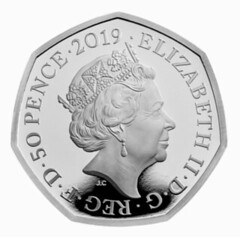
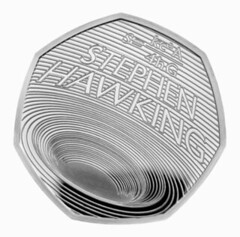
The Royal Mint has released (12th March) new commemorative coins which are in remembrance of the late physicist Stephen Hawking, internationally renowned for his pioneering work on black holes. This work, which used a tentative unification of Einstein's theory of general relativity with quantum mechanics, reported that black holes should not be completely black and instead emit radiation, meaning they evaporate and eventually disappear.
A black hole is a region of spacetime exhibiting such strong gravitational effects that nothing, not even particles and electromagnetic radiation such as light, can escape from inside it. The theory of general relativity predicts that a sufficiently compact mass can deform spacetime to form a black hole. Termed "Hawking radiation," this was an unexpected but highly influential development. The fact that something can come out of black holes means that they are not truly black, as people originally thought. In fact, over enough time, Hawking radiation can lead to black holes eventually evaporating and disappearring.
Hawking's discovery led physicists to the unavoidable conclusion that information is lost as a black hole forms and subsequently evaporates. This is the black hole information paradox, one of the greatest unsolved problems in theoretical physics. These theories and phenomena are explained in his most famous work, A Brief History of Time.
Following his cremation, a service of thanksgiving was held at Westminster Abbey on the 15th June 2018, after which his ashes were scattered in the Abbey's nave, alongside the grave of Sir Isaac Newton and close to that of Charles Darwin. Inscribed on his memorial stone are the words "HERE LIES WHAT WAS MORTAL OF STEPHEN HAWKING 1942 - 2018," along with his most famed equation.
The 50-pence coin is designed by Edwina Ellis, whose design is inspired by a lecture he gave in Chile in 2008. The reverse side cleverly depicts a black hole on the surface of the coin in a carefully aligned linear approach, giving the appearance that there is an actual chasm on the coin's surface.
The black hole depiction is pretty cool, more at home on an art medal than a circulating coin. But I'm left with the feeling the Royal Mint could have done better with this one. The upper half of the reverse design with the equation and lettering are pretty bland. -Editor
To read the complete article, see:
United
Kingdom: Famed physicist Stephen Hawking and his groundbreaking achievements celebrated on new 50-pence coin
(http://news.coinupdate.com/united-kingdom-famed-physicist-stephen-hawking-and-his-groundbreaking-achievements-celebrated-on-new-50-pence-coin/)
STAR OF ITALY FOR WOMAN WHO FOOLED NAZIS
This article from The Times is about the awarding of a Star of Italy medal to a brave woman who defied Nazis and saved her village. -Editor
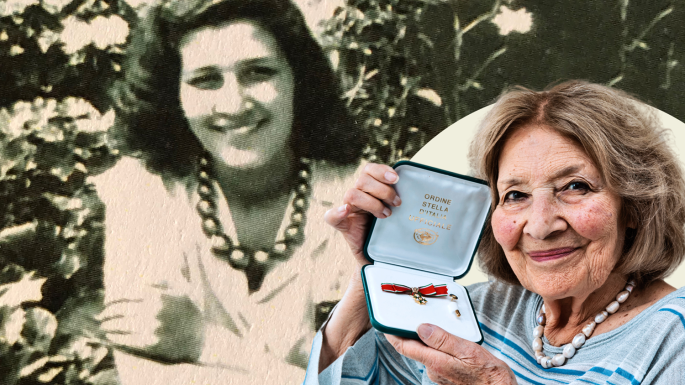
Gabriella Ezra was 17 on the day that she saved every man in her Italian village from being shot by the Nazis.
Although now 91 and living in Brighton, East Sussex, her memory of the courage she mustered at the end of the Second World War is as vivid as ever.
Her intervention to save the lives of her father, Luigi, and 37 other men of Cappella di Scorze, near Venice, has been recognised by the Italian government, which has inducted her into the Order of the Star of Italy.
She recalled the morning of April 28, 1945, when she confronted a German officer in charge of a firing squad and lied to him, putting her own life at risk.
The Germans, who had occupied the country since the Italian surrender in 1943, were preparing a reprisal for an attack by Italian partisans.
Ms Ezra was fluent in German because of her childhood in Austria. "I told my mother I had to do something so I ran after the officer and pleaded with him that these men were just farmers who cared about their fields and cows. He took me to the commandant and I begged him not to kill them, telling him again and again these men were innocent.
"They took me outside and lined up the men with a firing squad and said: 'This woman tells me you are innocent. If she's lying I'll kill you all, her first'."
Ms Ezra was lying. Some of the men were partisans and were carrying evidence of their loyalty to the resistance when they were arrested.
"They searched the men but they had hidden their partisan armbands in the cowshed," Ms Ezra said. "The men were led away and my father passed me his watch and a note to my mother because he didn't think he would survive."
The commandant released the men with a warning that if there were any more attacks he would destroy the village. "Early the next morning we heard an engine and thought the Germans had come back. But it was actually a British soldier who was there to liberate us and he just wanted someone to rustle him up some breakfast."
She added: "When the British came we cried tears of joy and embraced them. It was such a relief."
To read the complete article, see:
Reward at last for the
girl who saved a village from the Nazis
(https://www.thetimes.co.uk/article/pensioner-given-medal-for-saving-village-from-destruction-by-nazis-74-years-ago-lp39pfl39)

JAPAN'S MANHOLE COVERS
You read it here first - manhole covers as collectibles. See the links below for earlier E-Sylum articles on the topic. Be on the lookout for the Whitman Guide Book of Manhole Covers. Here's an excerpt from an Atlas Obscura article on the populatity of Japan'scolorful mancover covers. -Editor

In Japan's glittering cities, all hustle and light, they can be easy to miss. With all that sensory assault, who thinks to look down and take notice of something as mundane as a manhole cover? But these are no ordinary bits of civic infrastructure. In Japan, many manhole covers are works of urban art-elaborate, curious, distinctive, even colorful. They have become a tourist destination unto themselves, and attract a legion of dedicated manhole enthusiasts who travel the country to visit some of the thousands of unique designs.
Japan's decorated manhole covers-broadly encompassing storm drain, domestic water supply, electrical and other utility access covers-initially took shape as a public relations campaign for sewers. Beginning in the 1950s, the cast plates featured simple geometric patterns, such as the "Tokyo" and "Nagoya" designs. Japanese civil servant Yasutake Kameda conceived of the intricate, artistic versions in 1985, to help warm a skeptical rural population to the idea of the costly but necessary modernization of the country's sewer system. From these humble, practical beginnings, manhole covers have become a cultural phenomenon.
The ornate manhole covers are initially carved from aluminum, which is used to make sand molds for casting. The majority of the designs are selected by local municipalities, in conjunction with manufacturers. In most cases, the design is just imprinted in the cover, but in some cases the covers get another touch-colored resins flooded into voids like enamel on jewelry.
Such is the popularity of these little urban treasures that they have a devout, organized following. There is the industry-led Japan Ground Manhole Association, and the fan-based Japanese Society of Manhole Covers, whose website features thousands of photographs submitted by users across Japan, who have snapped everything from large sewer covers to tiny local utility access panels.
To read the complete article, see:
On the Hunt for Japan's Elaborate, Colorful Manhole Covers
(https://www.atlasobscura.com/articles/japanese-manhole-covers
To read the earlier E-Sylum articles, see:
THE E-SYLUM 2014 APRIL FOOL'S ISSUE (https://www.coinbooks.org/esylum_v17n15a17.html)
PAUL BOSCO ON MANHOLE COVERS AND NUMISMATICS (https://www.coinbooks.org/esylum_v17n16a30.html)
MANHOLE COVERS AS NUMISMATIC OBJECTS (https://www.coinbooks.org/v22/esylum_v22n08a07.html)
COMMEMORATIVE MANHOLE COVERS (https://www.coinbooks.org/v22/esylum_v22n09a11.html)
WALLET HELPS IDENTIFY BANKNOTE DENOMINATIONS
The South China Morning Post has an article about a woman who designed a wallet to help the visually impaired identify banknotes. Here's an excerpt. -Editor
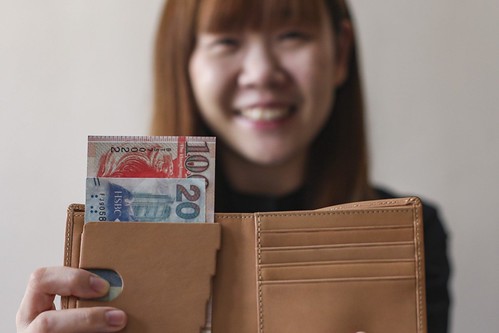
Flipping open a brown leather wallet, Hong Kong designer Comma Leung Man-wai closes her eyes and runs her fingers across a stash of banknotes of various denominations inside. She singles one out and accurately identifies it as a HK$100 bill.
But this is no magic trick.
The wallet, created by Leung, 29, has a special panel attached inside which allows a user to slide notes up against it and tell their value according to width. Looking no different from any other wallet on the outside, it is specially designed for the visually impaired.
The wallet is the first signature offering from Leung's studio. She originally came up with the idea for her graduation project while majoring in communication design at Polytechnic University.
Her inspiration came from an experience one day, when she saw a man walking with a crutch in Shek Kip Mei. Leung observed that he almost stepped into flower beds or nearly fell down stairs several times.
The man's struggles moved her, and she introduced herself to him, wanting to know if she could help. He then led her to the NGO Hong Kong Society for the Blind, where she met Au Kit-ying, 33, who is visually impaired.
Having spent some time together, Leung found that Au often had difficulty distinguishing denominations of banknotes, which was what sparked the wallet idea.
It took her half a year to complete the design, including taking Au to the market to choose suitable materials.
After graduation, Leung spent half a year improving the wallet's design, including crowdfunding it in 2016 to raise HK$300,000 to produce 1,500 pieces.
Leung has also designed other products for people with disabilities.
These include a coin purse catering to those with cerebral palsy and who have difficulties using their fingers. A special rim on the purse lid allows the user to simply get coins neatly by tilting the purse without having to rummage inside.
To read the complete article, see:
How a Hong Kong designer came up
with a wallet that can help the visually impaired identify banknote denominations
(https://www.scmp.com/news/hong-kong/health-environment/article/3002869/how-hong-kong-designer-came-wallet-can-help)
NEW JERSEY BANS CASHLESS STORES
We've been following the rise of cashless stores and the subsequent municipal backlash. Last week we reported the news that Philadelphia had banned cashless stores; this week the neighboring state of New Jersey followed suit. -Editor
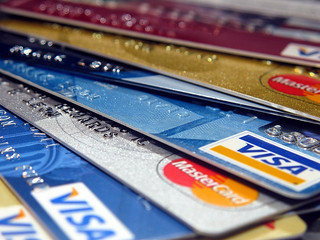 On Monday, New Jersey Governor Phil Murphy signed a bill banning cashless retail stores and restaurants in the Garden State. Murphy's signature
makes New Jersey the second state in the US to ban cashless stores, after Massachusetts banned them in 1978.
On Monday, New Jersey Governor Phil Murphy signed a bill banning cashless retail stores and restaurants in the Garden State. Murphy's signature
makes New Jersey the second state in the US to ban cashless stores, after Massachusetts banned them in 1978.
More recently, New Jersey's move follows that of Philadelphia, which banned cashless stores earlier this month. Philadelphia's legislation was a reaction to a growing number of stores that only accept credit cards or require customers to pay with an app, like Amazon's new Amazon Go stores.
Much like Philadelphia's new law, New Jersey's law makes an exception for parking garages and car rental companies, where a credit card is required upfront for incidentals. There is also an exception carved out for some airport stores, according to NJ.com.
Proponents of cashless stores say that they prevent theft, speed up customer convenience, and are generally more modern. Opponents say that cashless stores unfairly disadvantage people who don't or can't have credit cards and who don't want the fees associated with prepaid debit cards.
I hadn't realized that Massachusetts had already banned cashless stores as far back as 1978. -Editor
To read the complete article, see:
New Jersey becomes second state to
ban cashless shops and restaurants (https://arstechnica.com/tech-policy/2019/03/new-jersey-becomes-second-state-to-ban-cashless-shops-and-restaurants/)
To read the earlier E-Sylum article, see:
PHILADELPHIA BANS CASHLESS STORES (https://www.coinbooks.org/v22/esylum_v22n11a31.html)
LOOSE CHANGE: MARCH 24, 2019
Here are some additional items I came across in the media this week that may be of interest. -Editor
Von Hayek's Medals Set Auction Records
For those who haven't been paying attention, these auction prices are worth a look. Medals are on a roll. -Editor
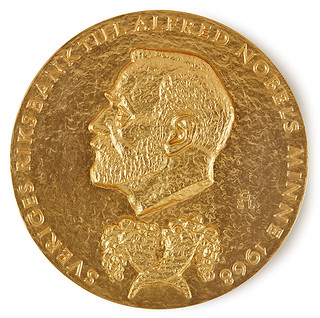 A new record for any item sold in an online-only sale at Sotheby's was set today when Friedrich von Hayek's Nobel Memorial Prize for Economic Science
sold for £1.1 million / $1.5 million, almost triple its pre-sale low estimate (£400,000-600,000).
A new record for any item sold in an online-only sale at Sotheby's was set today when Friedrich von Hayek's Nobel Memorial Prize for Economic Science
sold for £1.1 million / $1.5 million, almost triple its pre-sale low estimate (£400,000-600,000).
Von Hayek's Nobel Prize, awarded for "pioneering work in the theory of money and economic fluctuations", led Sotheby's online-only sale of 27 lots from his personal collection which together realised £2.04 million / $2.67 million, quadruple the pre-sale estimate (£445,000-670,000).
Elsewhere in the sale, von Hayek's personal underlined and annotated copy of Adam Smith's The Wealth of Nations, estimated at £3,000-5,000, sold for £150,000 / $196,365, and the Presidential Medal of Freedom presented to von Hayek by President George H.W. Bush in 1991, estimated at £10,000-15,000, reached £112,500 / $147,274.
Not a bad price either for an out-of-copyright book that someone scribbled in... -Editor
To read the complete article, see:
Friedrich von
Hayek's £1.1 million Nobel Prize sets online only auction record at Sotheby's
(http://artdaily.com/news/112153/Friedrich-von-Hayek-s--pound-1-1-million-Nobel-Prize-sets-online-only-auction-record-at-Sotheby-s#.XJekAShKiAs)
Jimmy Hayes Discusses Bullion Taxes
A March 18, 2019 Coin Update piece interviews ICTA Executive Director Jimmy Hayes about U.S. state silver and gold bullion taxes. -Editor
To read the complete article, see:
ICTA
Executive Director Jimmy Hayes discusses silver and gold bullion taxes in U.S. states with James Anderson of SD Bullion
(http://news.coinupdate.com/icta-executive-director-jimmy-hayes-discusses-silver-and-gold-bullion-taxes-in-u-s-states-with-james-anderson-of-sd-bullion/)
Ugandan Counterfeiter Pleads Guilty
Dick Hanscom forwarded this Daily Mail piece about the head of an international counterfeit U.S. currency operation. -Editor
A son of missionaries who later married into the family of an African dictator has admitted to his role in an international counterfeiting operation.
Ryan Gustafson, 28, an American married to the granddaughter of the late Ugandan dictator Idi Amin, pleaded guilty to conspiracy and counterfeiting counts on Thursday in Pittsburgh.
The Pittsburgh Post-Gazette reported that prosecutors said Gustafson's operation was uncovered after one of his confederates bought coffee in Pittsburgh with a fake $100 bill.
The U.S. Secret Service said Gustafson had originally been arrested in Uganda in 2014 when police there raided his residence and found fake money and other evidence linking him to a counterfeiting ring.
Gustafson, who is the son of missionaries and is originally from Montana, was extradited from Africa to Pittsburgh in December 2015 to face trial here.
To read the complete article, see:
American man
married to granddaughter of the late Ugandan dictator Idi Amin charged with producing $2 million in counterfeit notes that were bought and sold on the Dark
Web (https://www.dailymail.co.uk/news/article-6839251/American-man-married-granddaughter-late-Ugandan-dictator-faces-money-laundering-charges.html)
FEATURED WEB SITE: NUMISMATIC NOTEBOOK
This week's Featured Web Site is Numismatic Notebook, a blog published by Jim Downey.Jim writes:
I have started a numismatic blog, www.numismaticnotebook.com. I started it because a number of non-numismatic friends asked about something I posted on Facebook on Veterans Day. It is intended for non-numismatists so the posts are not long nor are they in-depth.
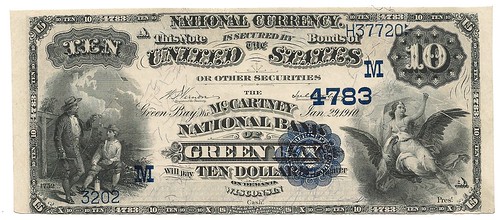
I think E-Sylum readers will enjoy this - a number of different numismatic topics are covered nicely with multiple illustrations. The most recent post is on the collapse of the McCartney National Bank of Green Bay. Other articles cover topics such as paying WWII Prisoners of War, Women in the Military, the Esperantist Checking Bank, and Secretary of the Treasury Samuel Dexter.
https://numismaticnotebook.com/

